Thursday, 4/20/23: Santarém to Golegã [31+ km]
Video to come!
I finally made it to Golegã! It took me several miles of walking through the agricultural land to realize I should follow the yellow arrows, not Google Maps. What a long first day. It was nearly 20 miles of walking (solo) through all sorts of terrain: cobblestone, asphalt, dirt, gravel. In the last few miles, I constantly checked my watch…but 30 km / 18.6 miles (estimate on the map) ticked and I was no where near the end of the day.
The Norwegian girl left around 5ish, without much of a peep. The French woman was getting ready around the same time as me, but she was headed to a place called Fatima. I guess I’m doing this alone! At 6:30 am, I watched for dawn break while slowly eating breakfast, composed of my grocery haul from last night: banana and apple pie. I kept the liter of Compal peach nectar for the walk. Energy gel and hydration in juice form.
I am oddly energized and surprisingly not jet lagged. My sleep has been off the last few days: crying baby on the plane, effectively a 3 am Eastern time entrance to Lisbon, girl coughing all of last night at the Lisbon Hostel. And it’s technically 1:30 am back home. But adrenaline’s on my side!
I wandered out of the hostel and dropped my key in the box, as instructed. The cobblestone streets were empty save a few construction workers. I whispered bye to the row of pink peony trees that lined the street between the hostel and the traffic circle and nodded “bom dia” to the early morning risers. One runner greeted me with “Bom Caminho.” It’s official!!!
I returned to the path I followed yesterday, following the same cobblestone path. Only this time, I went downhill.
Google Maps got me to the Riberia de Cabanas path and I start spotting yellow Camino arrows.
Silence all around except for the crunching of my feet on gravel and the occasional tractor. In contrast to the cool morning, in which I wore a fleece jacket, once the late morning sun came up, the heat is relentless. Too lazy to stop and put on sunscreen, I keep the longsleeve on and put on my untrendy sunhat.
Miles into this flat stretch of farmland, I see a farmhouse with an arrow tile pointing left. I stared at it, trying to make sense of it. Why trespass when I can just walk on the road, where people can see me?
I took a picture for reference. I made an executive decision to NOT follow it. Instead, I continued onward along the gravel path.
I soon regretted that decision. Had I followed it, I would have saved myself from being sideswiped by cars and trucks. Some wave and give a wide berth, others give me the staredown as they pass.
This agricultural path is lovely. I saw two horses, lots of vineyards, various other plantings, an elderly farmer on his tracker, and an assortment of wildflowers. Over 1.5 hours later, there was still no sighting of other pilgrims. When I came upon another arrow that differed from Google Maps, I followed it.
As I got closer to Vale de Figueira, I got passed by three very fast walkers. They had much smaller backpacks, day backs even. I was going maybe 20 minutes/mile. They were probably going a speedy 15 minute/mile. Not much of an exchange, just a quick wave and they were gone.
Vale de Figueira was cute! Lots of desert plants in people’s yards. In fact, many houses had birds of paradise flowers. The first time I ever saw these flowers were in Taiwan and learned its name 天堂鳥 (literal translation).
There were fruit trees bearing lemons, oranges, and a mystery fruit that I later learn is called nêspera. Until then, I just stealthily pick what I can reach.
It’s so good! It tastes like peach-apricot-plum all mixed into one.
At around Mile 7, I saw some cafes open. I should have stopped. But I didn’t. I paused for a few moments under a tree, taking a brief respite on a bench without removing my backpack. I watched ladies set up for a street market to sell clothes out of a van. If I stopped for too long, I might not get up.
The next section featured: little gecko-lizards that scattered about on the dirt path. They looked a lot like Taiwanese 壁虎 that climbed the interior walls of my grandmother’s house, only these were strictly outside. I passed an abandoned car by a river, and quickly kept going not knowing if there were vagrants or 流浪人 milling about ready to jump me in the secluded woods. Too paranoid?
Two cyclists passed me without any hellos. Still haven’t seen any pilgrims with big backpacks.
More farmland. The plants made interesting patterns. Some in neat rows. Some in ellipses. Looking up, flocks of birds were diving about making cool patterns in the sky. Crane-like birds with white bodies and black tails and that sort of walked like chickens followed behind a tractor spreading seeds, but the farmer didn’t seem bothered.
I’m very happy to have on my leggings today. Especially going through another path that had sharp weeds.
It was ridiculously hot. There was no shade since everything was farmland. Unbeknownst to me, there was a record breaking heat wave passing through Iberia, bringing July temps in April. Good thing I had a Nalgene of water and a liter of Compal!
I was getting so hungry. I expected to see another cafe or town on the way, but there was nothing but fields and fields. Major fail for not stopping earlier. Had I known there’d be nothing on this route, maybe I would have had the foresight to buy more food at the grocery store last night.
I finally sat near some solar panels before the path turned right and continued indefinitely. Pre-trip me packed 15 bags of energy chews, which I had gotten bored of eating during marathon training, strictly for emergencies. I pulled out a packet, to stave off the hangry.
More onward. Finally came upon a Camino tourist sign, which called out Golegã. High hopes I'm almost there! Maybe the next town has food!
No such luck. To my dismay, I didn’t see any cafes, grocery stores, or restaurants in the cute and small town of Azinhaga. I guess I’m not sleeping here tonight, either. I paused on a bench to look up hostels in the next town — it’s not looking super promising on booking.com. Maybe they keep some beds for people who don’t reserve? Too late to be anxious and concerned!
The Camino continued along a dirt path, with a sign indicating it’s part of the region’s biodiversity/biosphere reserve. One side had wildflowers abutting houses.
The other side of the path was a low-lying river topped with small boats.
One thing that is very common in Europe, but not in the US, is solar hot water heaters on rooftops. Why don’t we have this?! It’s way more energy efficient and would decrease our fuel usage for keeping hot water tanks circulating at all times. How is it not part of the US energy transition and decarbonization plan? Having worked in energy, this stuff boggles my mind.
Leaving Azinghaga was…ok. I naively thought I’d have a nice path, like I did this morning. Shut off my brain and walk.
It was pure awfulness after a morning of hot zen. There was a sign telling pilgrims to walk against traffic (it’s a nice reminder even if you know this is the default when walking on roads). Presumably, there should be a similar sign pointing in the other direction for cars to beware of walkers. You would think…
It was just me and my backpack on the sliver of the road’s edge. No median. No metal barrier. The speed limit was 70 km/hr (about 45 mph). Some drivers slowed down when passing me. Most others whipped by at speeds much higher than 45 mph, without scooting over a little. They looks they gave me!
It was like this for miles! I think 10k! I was under the sun for most of it. Couldn’t side step too far left because of the weeds and drainage ditch. I was pretty speedy on this section, according to my Garmin (thanks, Paul!).
I was relieved to finally see another tourist map promising only a few km left until Golegā. Historically, this town was known for its fertile soil, hence all the surrounding farmland I walked by today.
Portugal is famous for the Lusitano horse, and Golegā is the Capital of Horse. Lusitanos are known for its gentle temperament and agility, and thus can be trained for a variety of purposes, from equestrian performances to horse-drawn carriage events. As such, Golegā is known for equestrian competitions and horse breeding, and is home to the National Horse Fair held every November.
I finally got to Golegã’s main welcome sign and clocked in at 19.26 miles. I passed a shady roadside cafe, but I didn't stop. I was hungry, tired, beat and determined (desperate?) to find a bed. I caught whiffs of horse upon entering the town. Nice.
I went to the first 15 euro albergue listed in Gronze.com, the website the Norwegian girl had shared with me. The main gate was locked and I couldn't figure out how to get in, but luckily the dogs let the owner know. He gruffily asked if I had a reservation. Of course I didn’t. I’m trying to work on my anxiety, be more open to uncertainty. I nervously said no and was prepared to beg. I was in luck. Turns out booking.com’s availability cannot be trusted.
He checked me in at the little cottage in the back — wrote down my passport number, stamped my credential, showed me my bed on the bottom bunk. The only other person was Karl, a German man in his 70s. While I took off my now-too-tight-shoes, a young lad from Holland named Aiseya (pronounced Isaiah) bounced in with a big smile on his face.
Claiming he saw me a few times today, he asked if I had a wide-brimmed hat. The first time he saw me was from a cafe (I guess probably in Vale de Figueira) — clearly he figured out this breakfast break before I did! And then he said he saw me again, when I took my break by the solar panels. He had hoped to catch up, but then I disappeared. Crazy – I didn’t see anyone, except the three Danish people passed me.
Aiseya started from Lisbon (as did Karl). Oh man, they’re doing the WHOLE thing.
Did you have trouble finding albergues along the way? I read it’s tricky. No, but I walked long days, mostly through industrial sections. Don’t worry, you didn’t miss much.
I still feel like a cheater for skipping the first 80 km.
Where’d you start from today? Santarém!
Oh! Me, too! Yea, I know, I saw you at the hostel last night. You shared a room with the Norwegian girl, right?
Yea, I wonder where she is. She left before me. I left at 6:30 this morning and followed Google Maps. Aiseya’s using the Buen Camino app, which took him out of Santarém using a slightly different route.
Not quite knowing what to do, I will observe and follow their lead. Shower. Food. Charge devices. Figure out tomorrow’s route. Elevate legs. Wash clothes. Hang clothes to dry. Journal. Play with dogs. So much to do! And it’s still light out!
I saw a Chinese family on my way to the grocery store – they own the store next door. I think they were just as surprised to see me as I was to see them. I asked, “這是超市嗎?” and the kid made so much fun of me because they owned a 雜貨店. Duh.
Another sustainability soapbox moment: At the corporate job I was most recently laid off from, I was in a sustainability role. Leadership’s ask was for us to “lead the industry,” but we were woefully behind even the most basics. So “thinking big” first required catching up to industry or regional standards. One to the projects I inserted myself on was the construction of a new plant in Europe, in which I advocated for following green building guidelines. Many of these programs are based on a point system. Some easy points are things like having bike racks and parking spaces under canopies to reduce heat island effects. One project I strongly pushed for was PV car park, like Disneyland Paris. The pushback I got was surprisingly shortsighted. Lo and behold, a few months after I got laid off, the government of the country where this plant would be passed a law requiring all car parks with more than 80 spaces to install solar canopies in over 50% of the spots. While this grocery store canopy isn’t PV powered, it’s shaded! Again, why are we not doing these low-hanging fruit projects in the US?!
The grocery store had an interesting bread retrieval process. It’s so noteworthy that this American took a video clip of it, after watching natives do it. You have to use the scooper to knock it to the tray, and then put on plastic gloves to then put it in a bag. You can’t just use tongs and put out in a bag.
I ate my assortment of food: premade tuna sandwich, strawberries, yogurt, banana, chips, cookies, two boxes of chocolate milk (great for recovery!), and a croissant. Saved the rest for tomorrow.
I didn’t really know what I was supposed to do with my time after walking. But the hospitalero Fernando showed me the outdoor hand laundry area during check in. Karl was all done with his chores and plotting tomorrow. His clothes were swaying in the breeze on the racks trying to catch the last rays of sunshine. So I guess that’s what I’m supposed to do next. Aiseya was in the middle of laundering his stuff. We chatted while I waited for the sink.
He was curious to know what brings me here. So much! Where do I start? He has only a shirt left to wash. Since I’m practicing NOT dumping my problems on other people, I reply simply, “Oh, you know, to figure out my life. You?” He’s here to challenge himself because he doesn’t consider himself to be “sportive” (athletic). He’s certainly sportive for taking on the Camino.
When done with my snack-dinner and laundry, I played with the dogs. The chocolate lab is a stellar soccer player. Very cute. The white dog is older and chiller. He wanted to be pet, but didn’t fetch.
From outside the high stone walls and metal gates, you see only a hint of the beauty inside. There’s a little garden with orange and nêspera trees, though they’re both bearing sad looking fruits. It’s incidentally also where the dogs go to poo. There’s another little yard next to the patio that has another gate that Fernando likes to keep closed, but the chocolate lab happily noses it open and waits for me to kick the ball there. That garden is lined with terrific smelling flowers, which Aiseya says is jasmine. There’s another row of rooms that seem to be for other sorts of tourists. There’s also a nonfunctional pool (too bad).
A retired American couple from Kentucky named Beau and <> were sipping cocktails on the patio. They’re walking the Camino as well, but don’t stay in the albergue bunkhouse with us. They get a nice room in the main house. I’m learning there are multitude ways to Camino. We chatted a bit about different things while I was playing with the lab.
While it’s still light out, I venture outside again to the town square and to scope out the direction for tomorrow.
Even the most mundane things are more fascinating when it’s in Europe.
Staying in the albergue bunkhouse was great. Our cottage had our bedroom with 3 bunks (6 beds total), a small kitchenette and dining area that serve as the common area, a shared bathroom, and a locked room. It ended up being just the three for the night. I’m not sure where the Norwegian girl ended up, but she booked ahead so she’s likely at a different hosteling town.
Dinner time was fun. Karl cooked a delicious looking dinner: tuna on a bed of salad and pasta. I had already eaten a massive amount of food, mostly sugar and carbs. He offered some to me and Aiseya, but I was too full from my junk food haul to have more. I think I offended him. He also put a LOT of salt on his salad (by mistake), and ended up tossing it. Aiseya ate a whole rotisserie chicken, mostly because he didn’t want to waste food, but admitted it was too much.
The three of us had a nice time chatting in our many languages: Aiseya and Karl in German (or as I find out later, Aiseya simply put German accents on Dutch words, not knowing if they were actual German words); Karl and I in Spanish (though neither of us really know the language well enough to have a real conversation); Aiseya and I in English. It turns out Aiseya studied Chinese in Taiwan for 6 months at 師大 — I’m curious to know more about that. Karl has walked four Caminos and is 72 years old. This is Aiseya’s first Camino and he’s 30 years old.
Aiseya asks if I know how to address his knee pain. I have no idea. He asks Karl, who proceeds to demonstrate various squats and stretches, using a chair for height not for balance. I aspire to be that fit, energetic, and adventuresome when I’m his age.
Fernando told us there’s a woman staying in the room by the bathroom, and that we are not to bother her. She came home late, walked into our stretching shenanigans. Fernando’s rules went out the door. She’s Mexican and here on a work training program to learn how to breed horses. So cool!
Lessons from today
Stop at the cafes! Food is not guaranteed anywhere!
Start early in the morning. It’s the best option to beat the heat and to allow laundry to dry.
Pants are friends! Thorns are not.
I made it! I can do it! This is a physical AND a mental game.
Follow the arrows, not Google Maps.
Be grateful I didn’t become roadside fodder today!
Keep my health up so I can continue this type of adventure for a lifetime!
Previous Day:
Next Day:
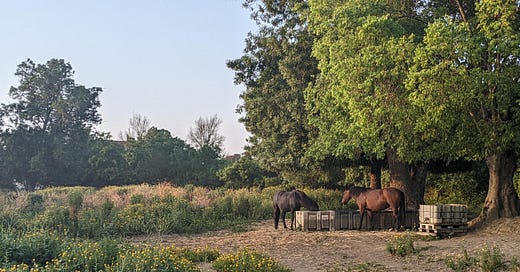




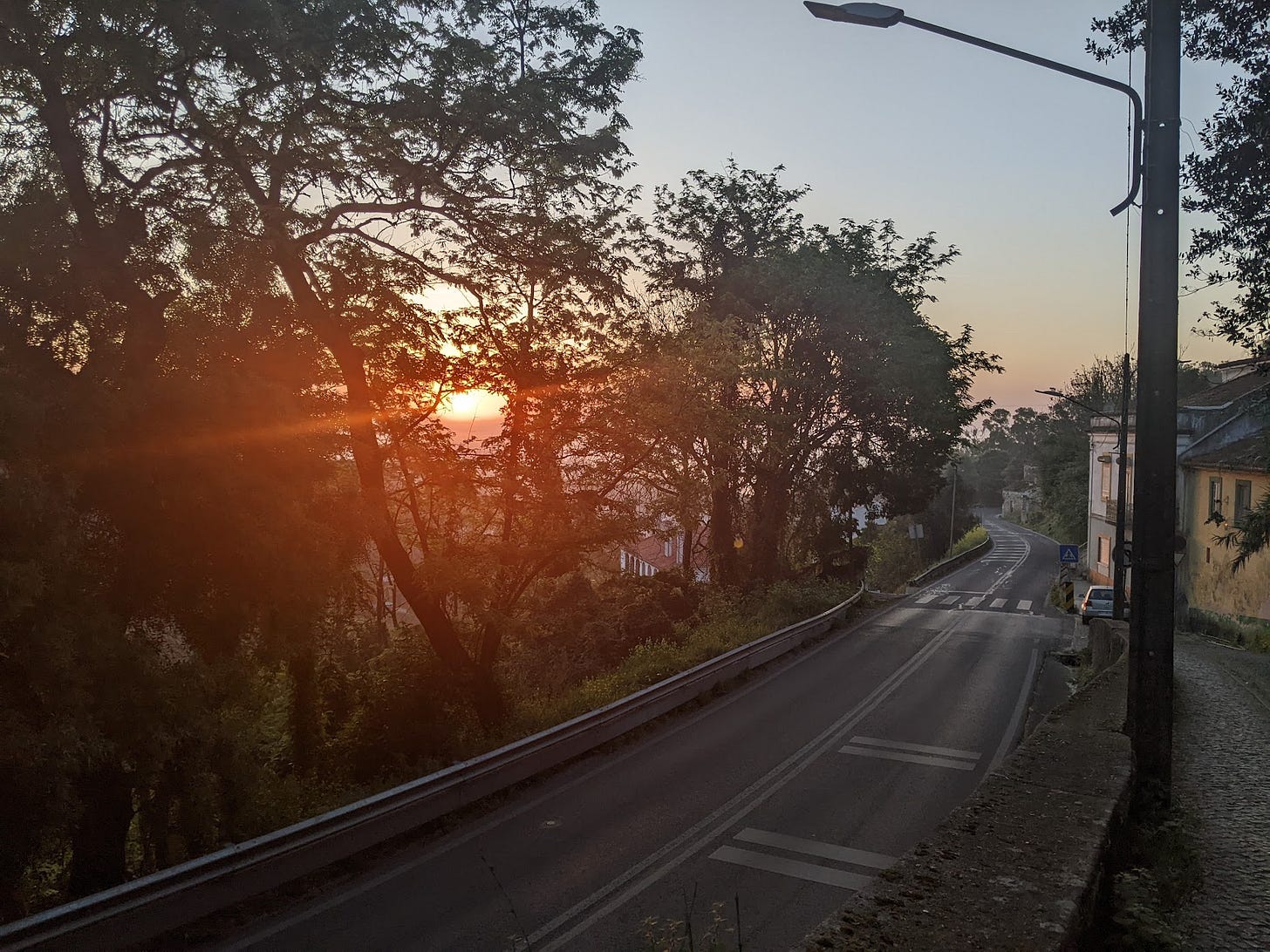
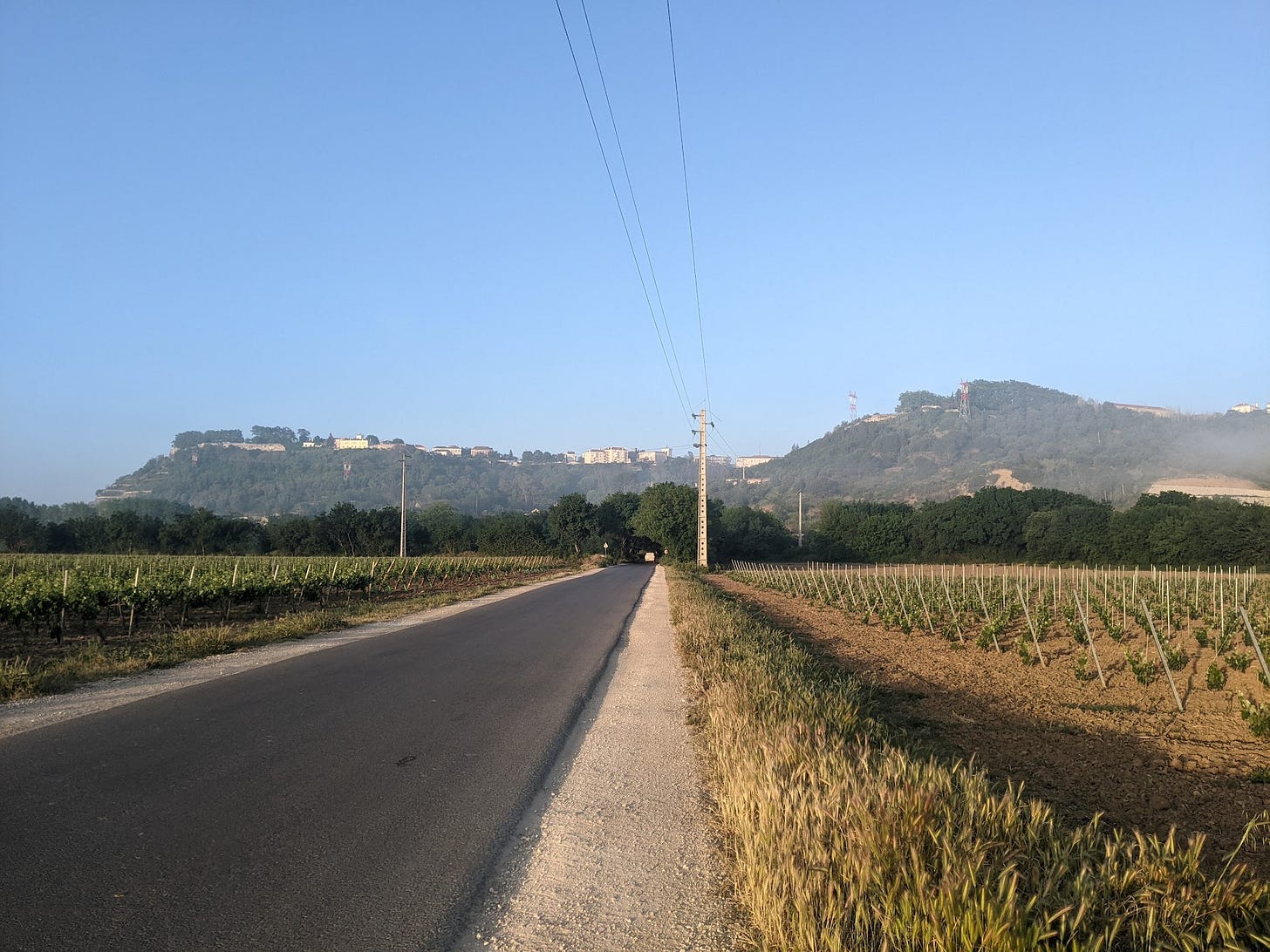
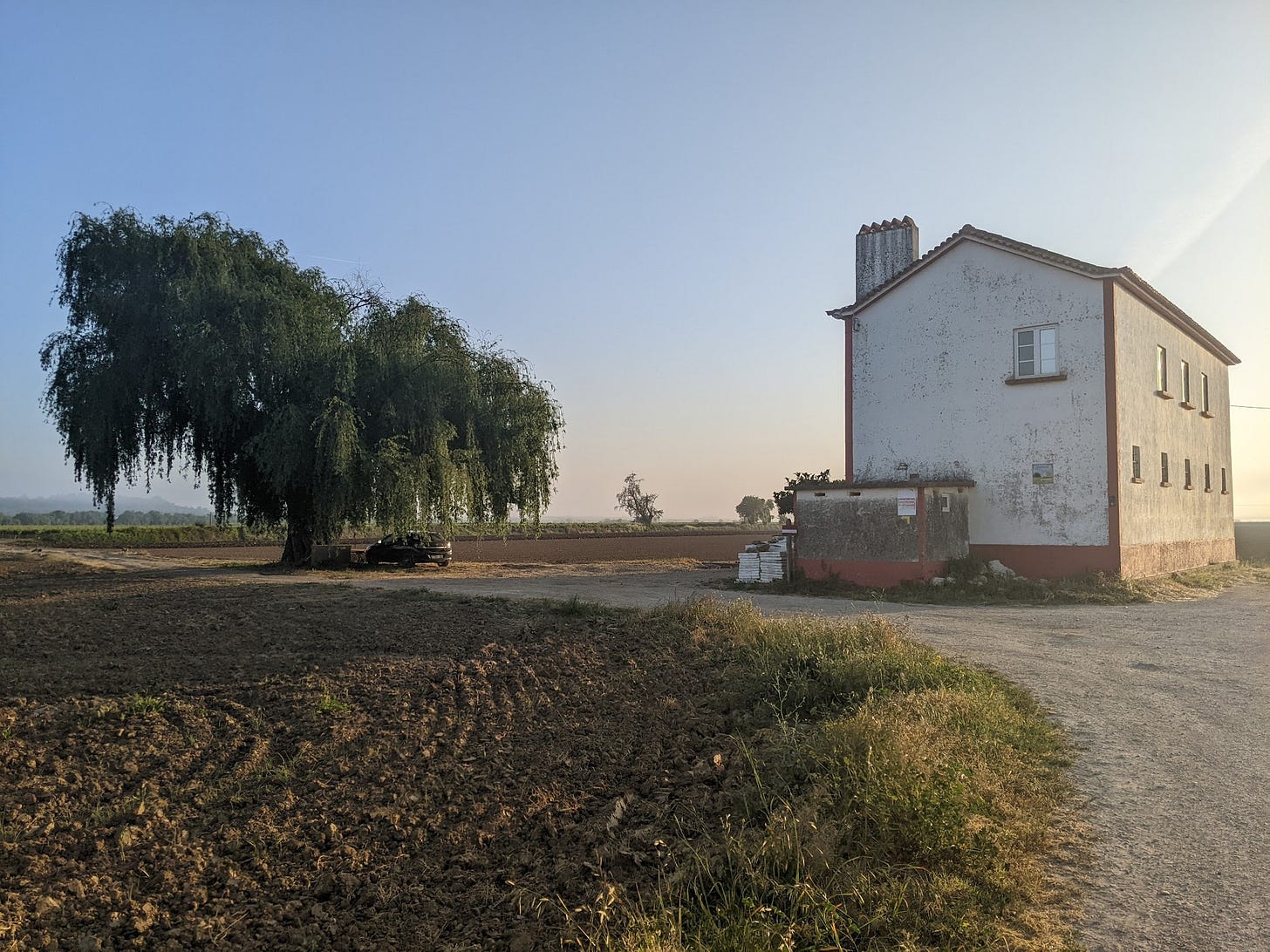
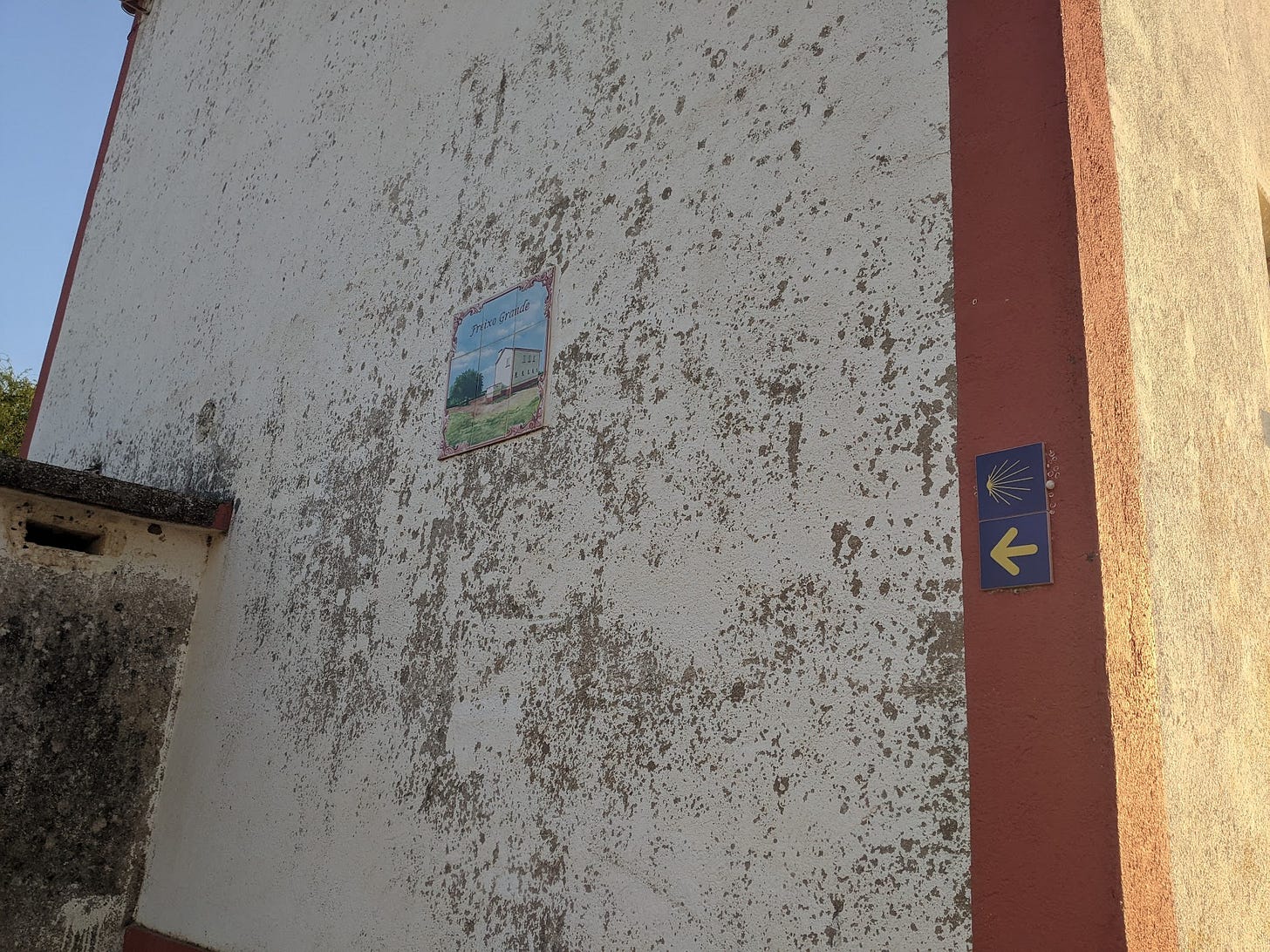
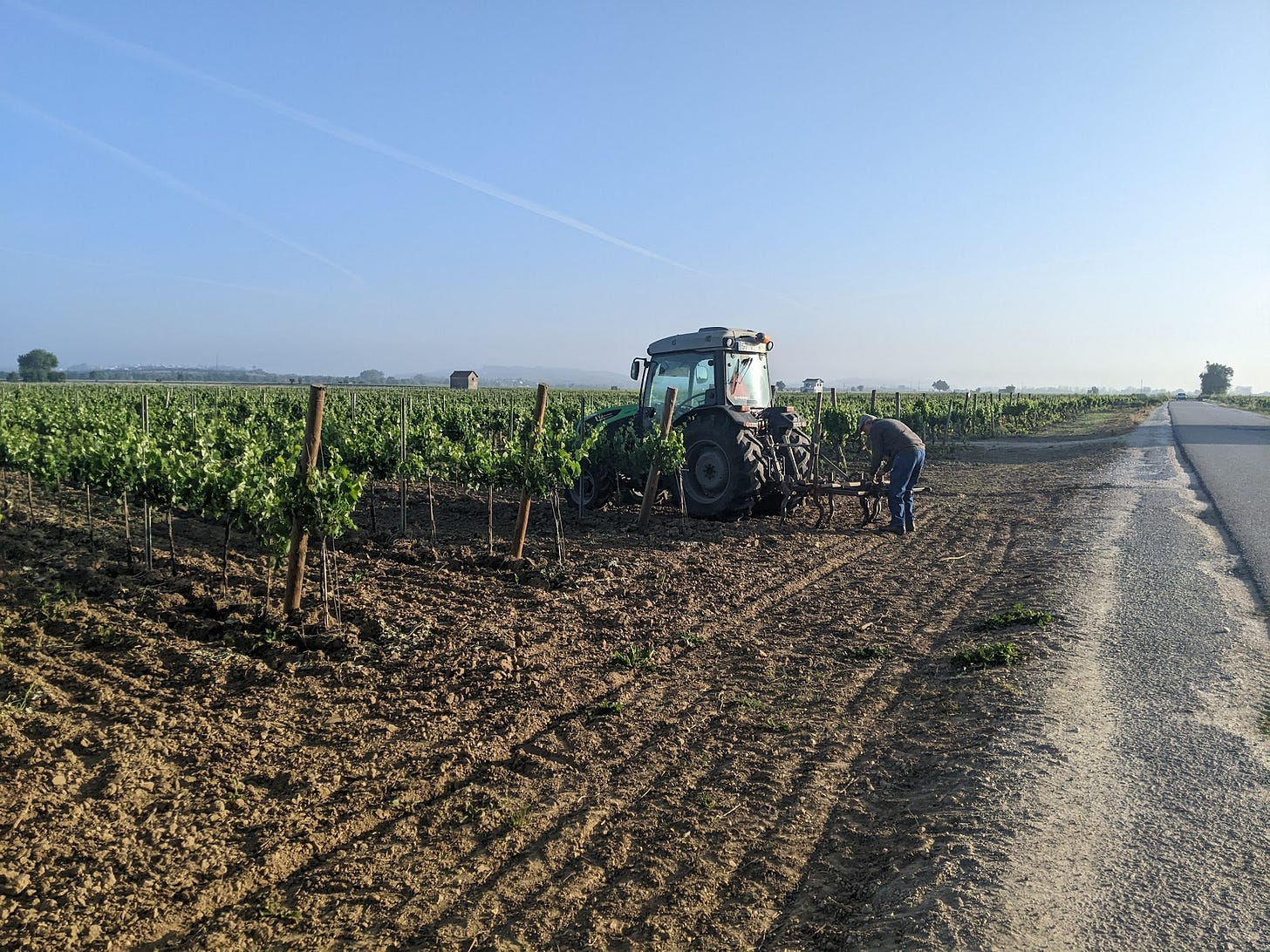
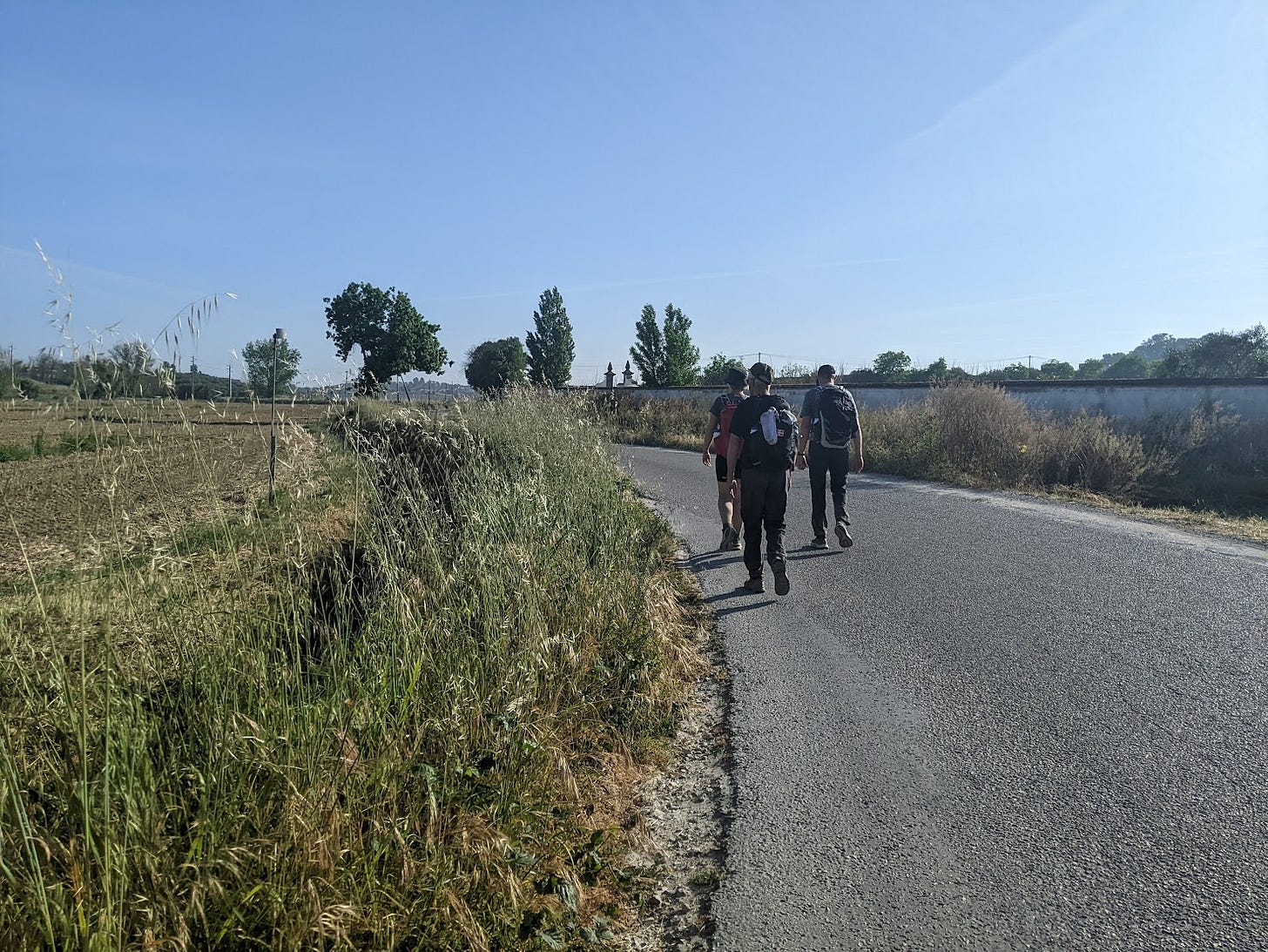
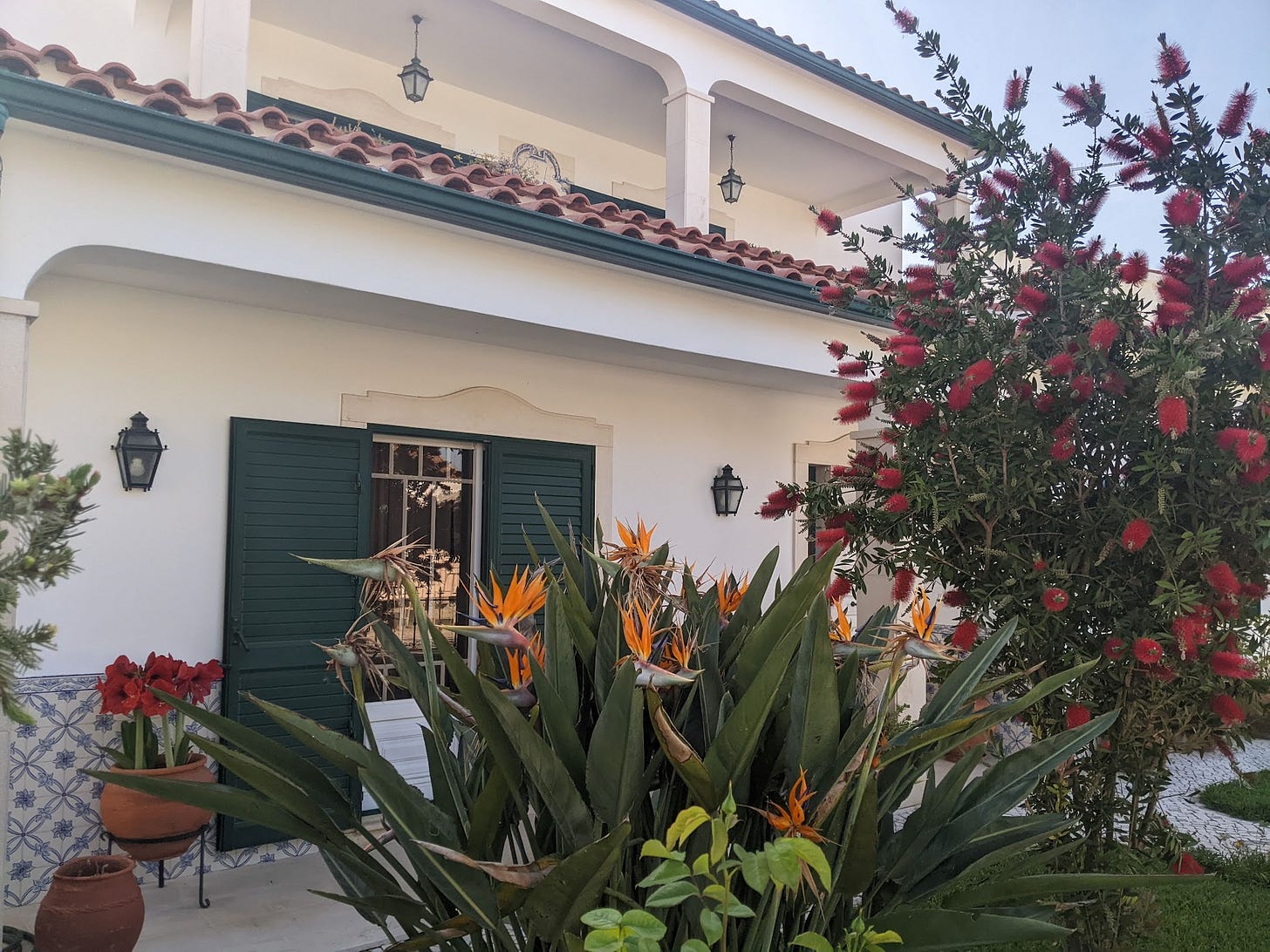

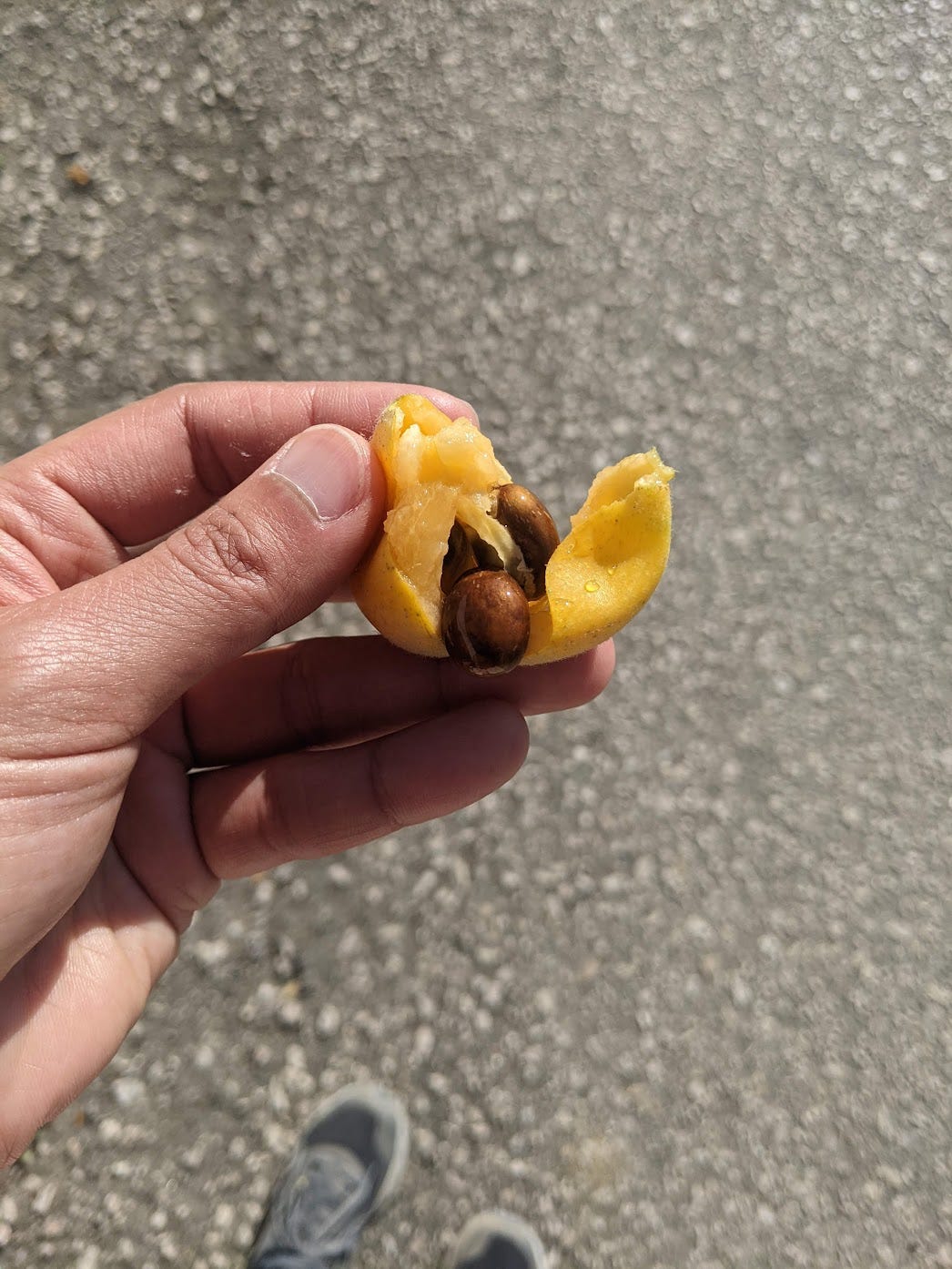
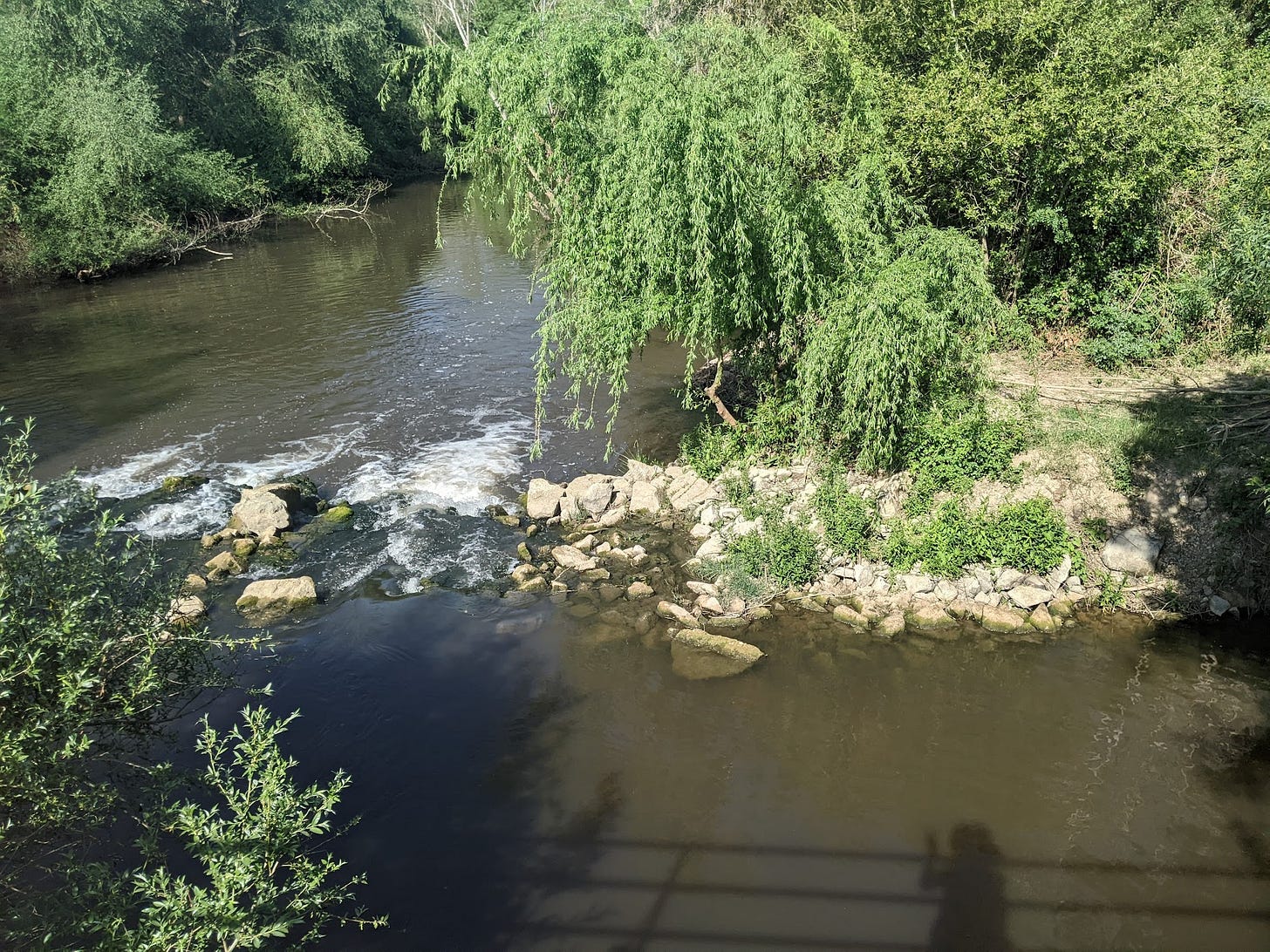
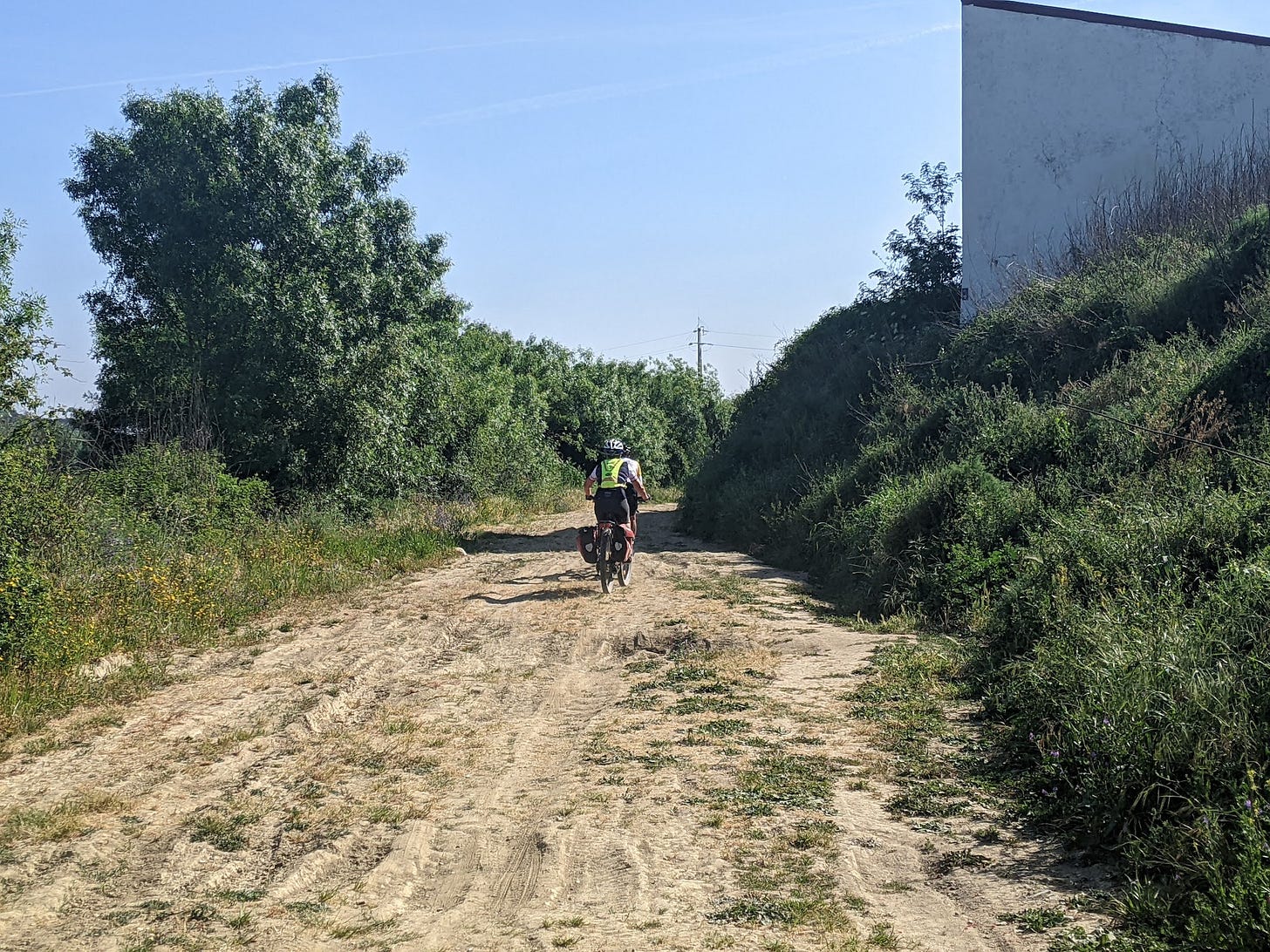
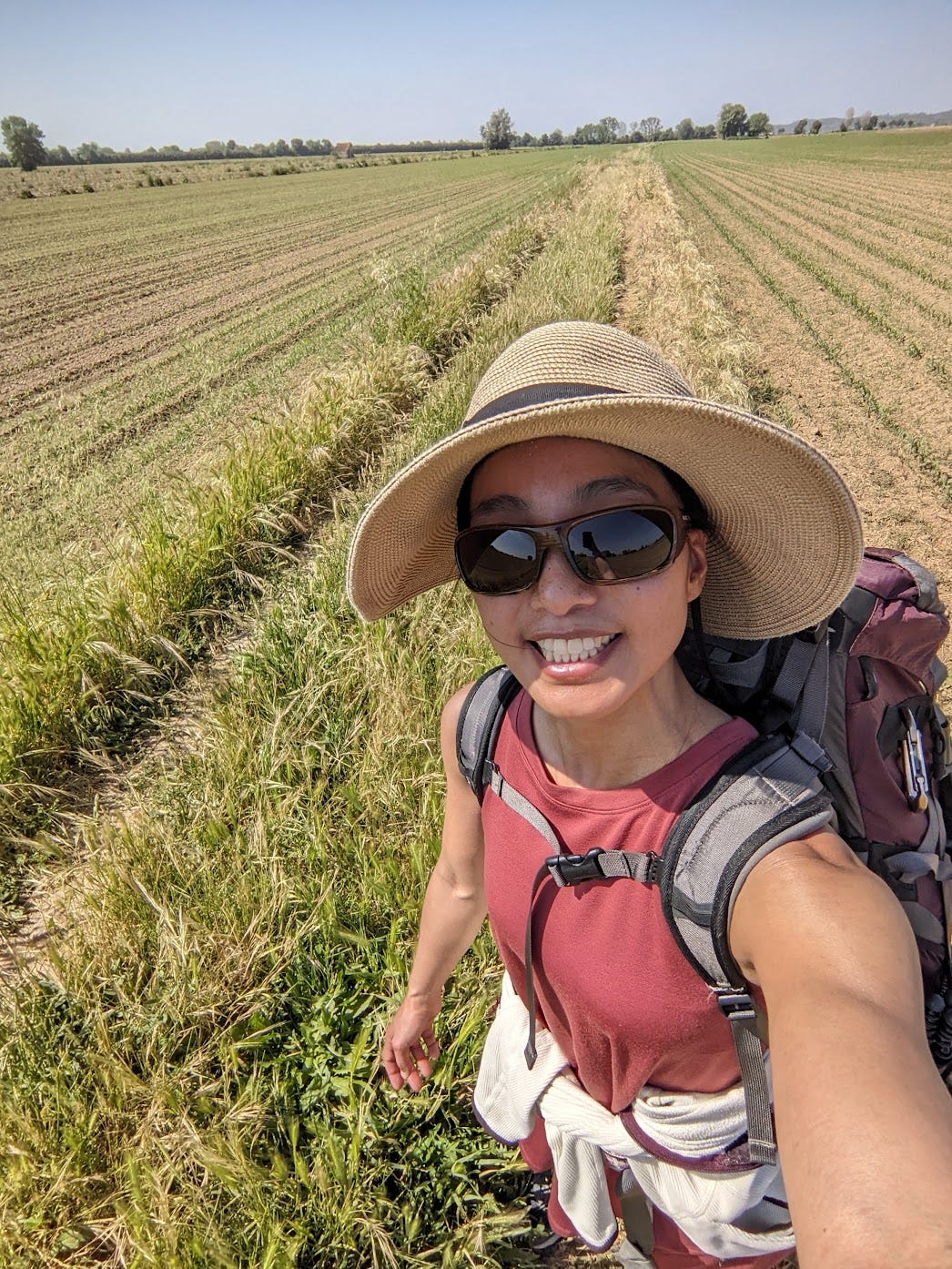
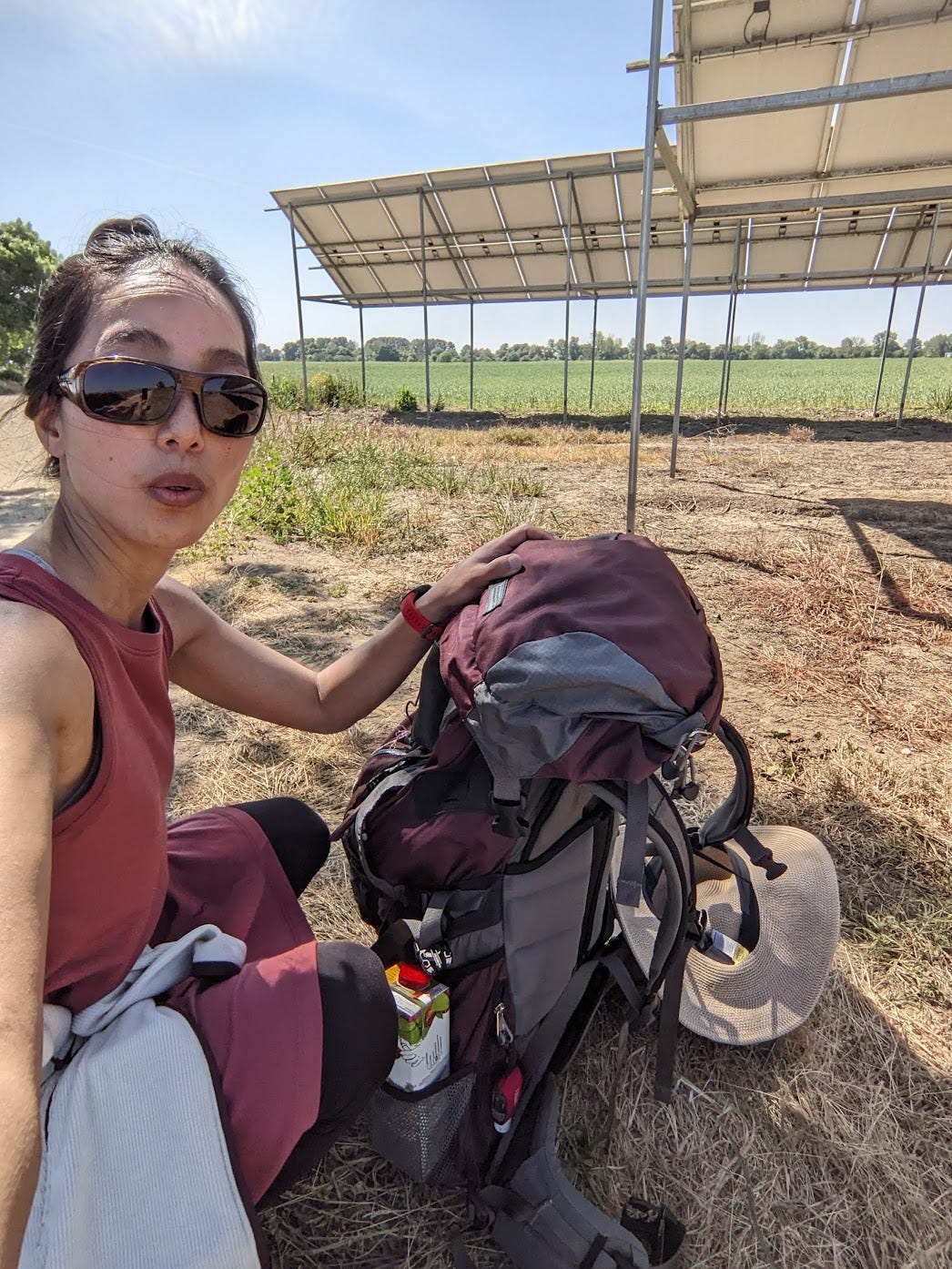
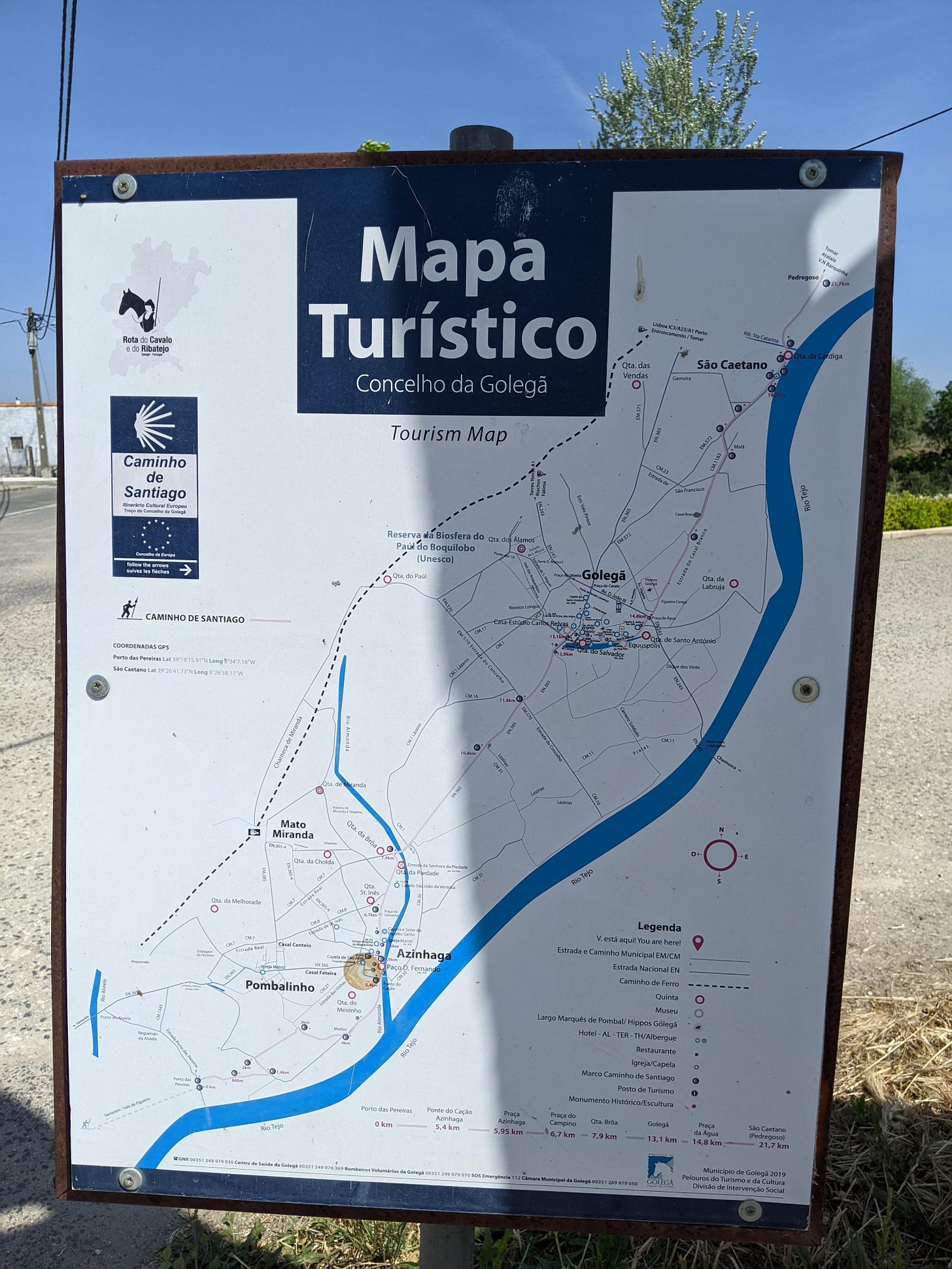
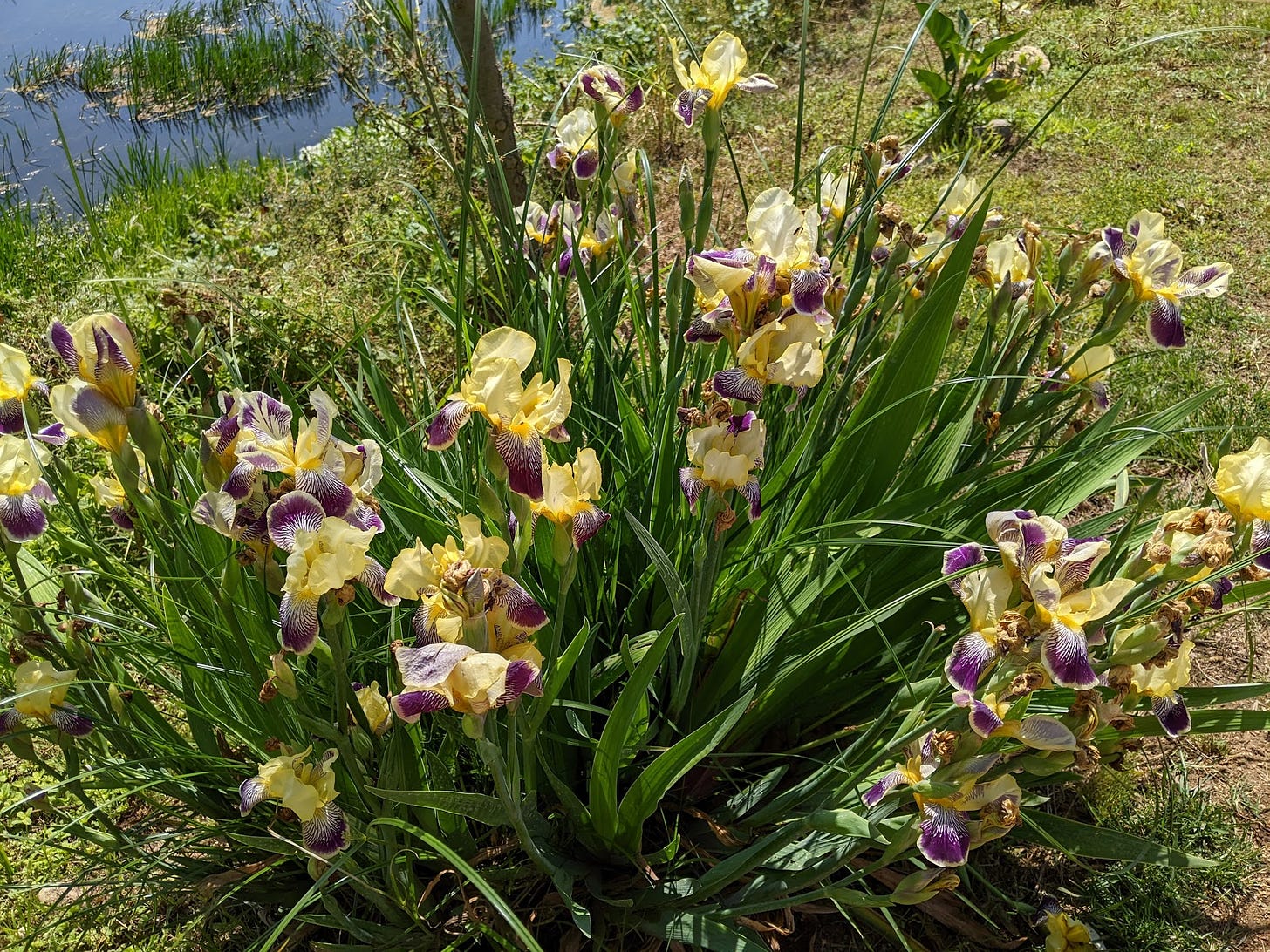
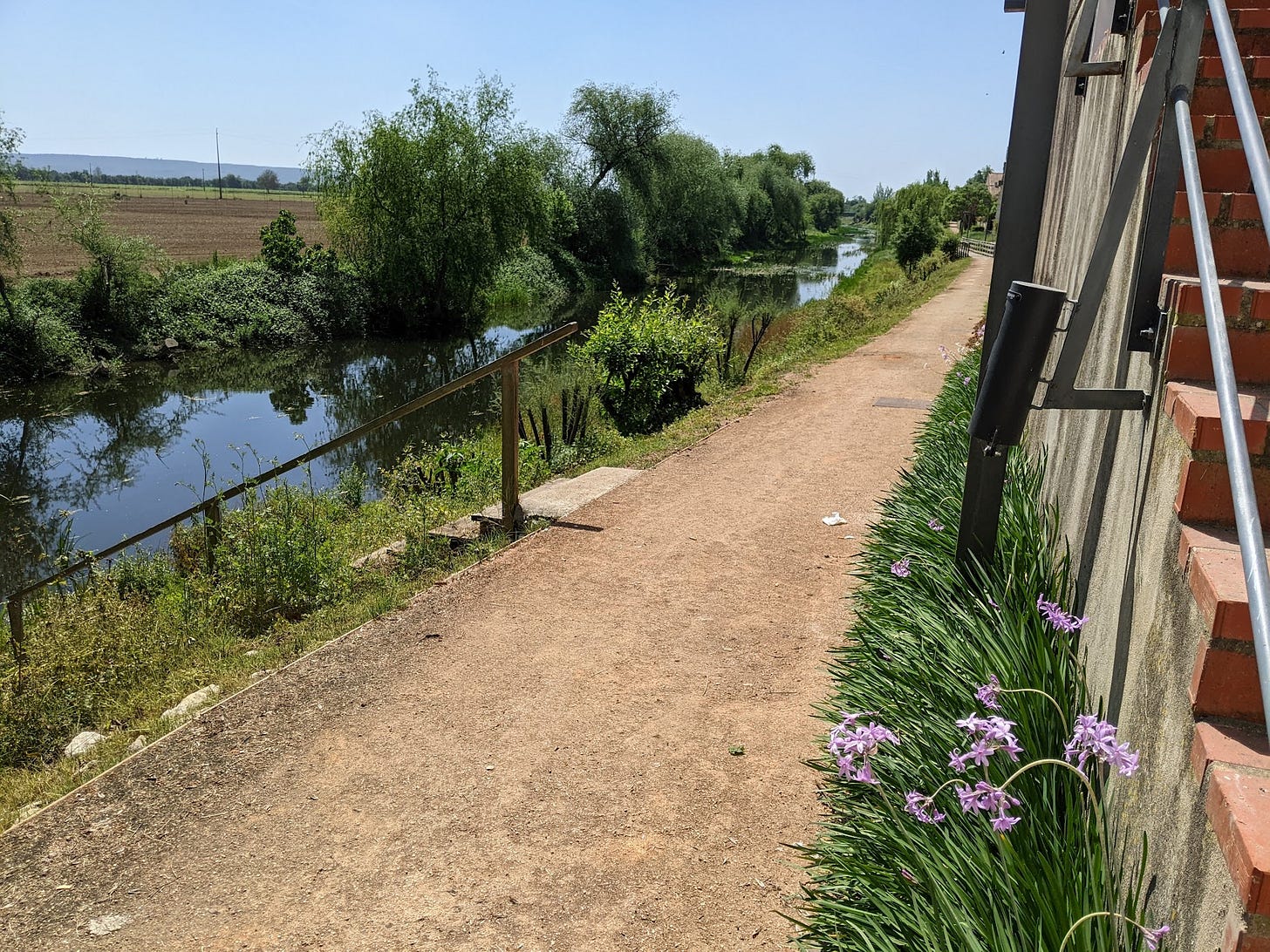
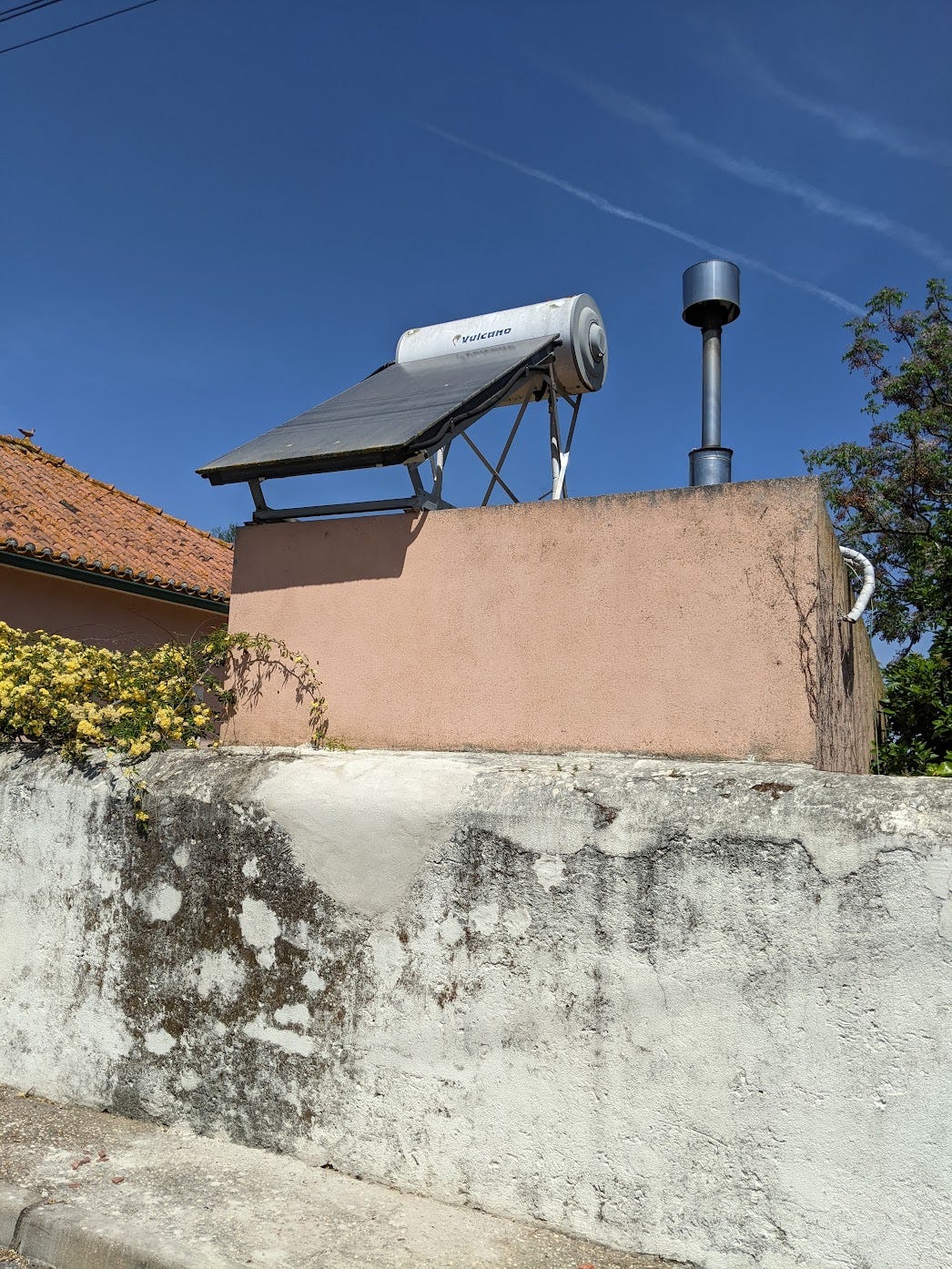
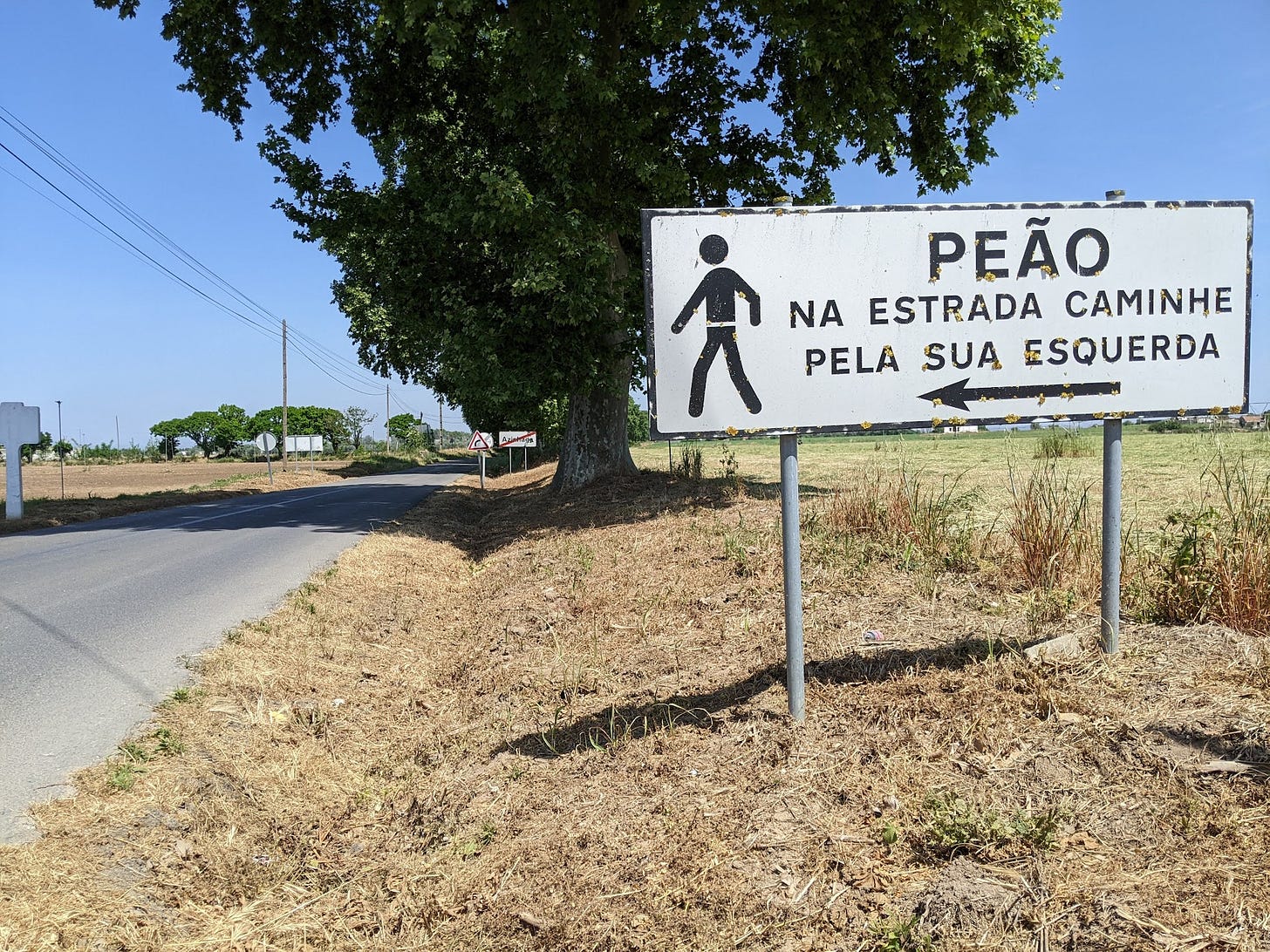
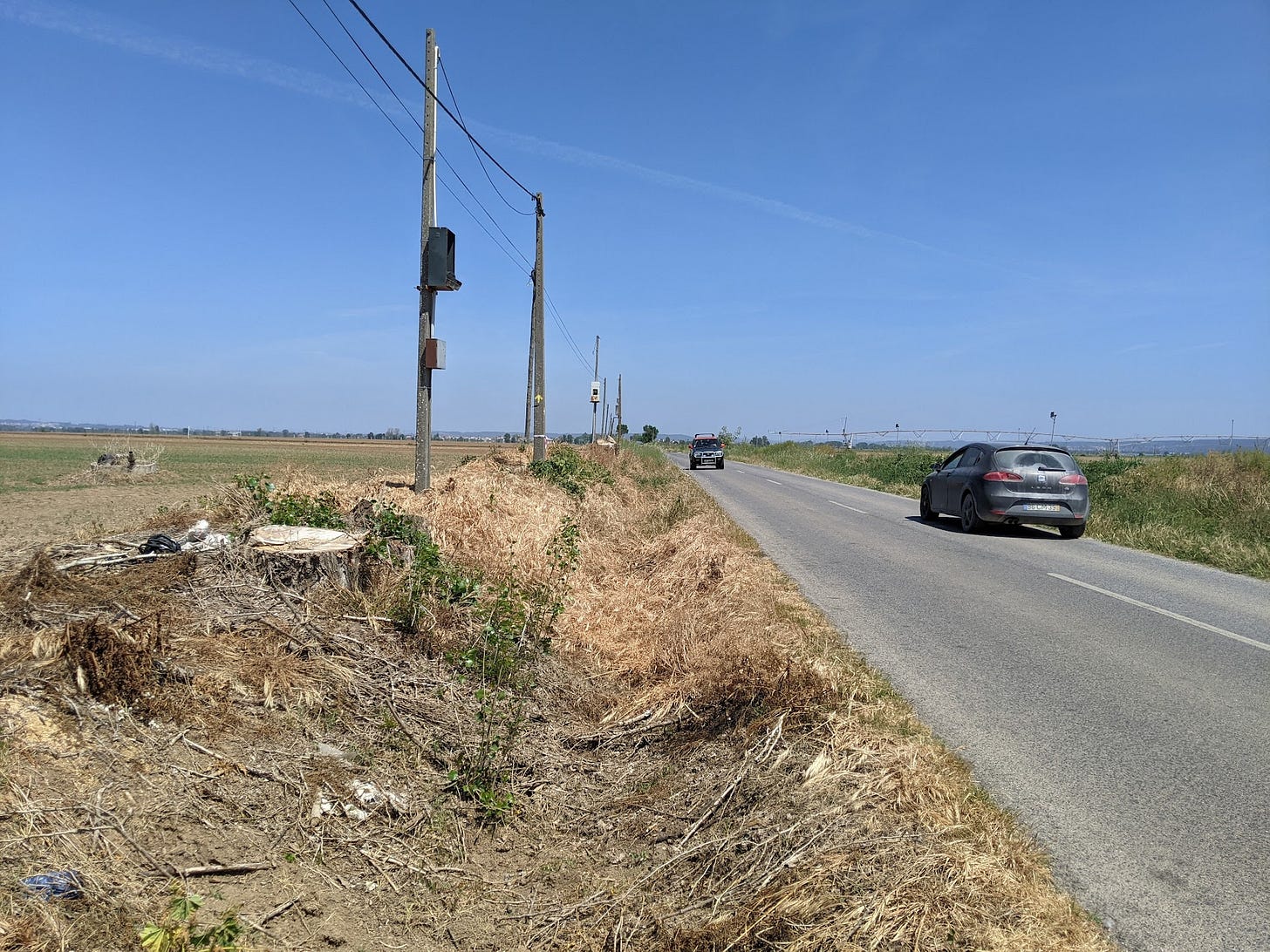
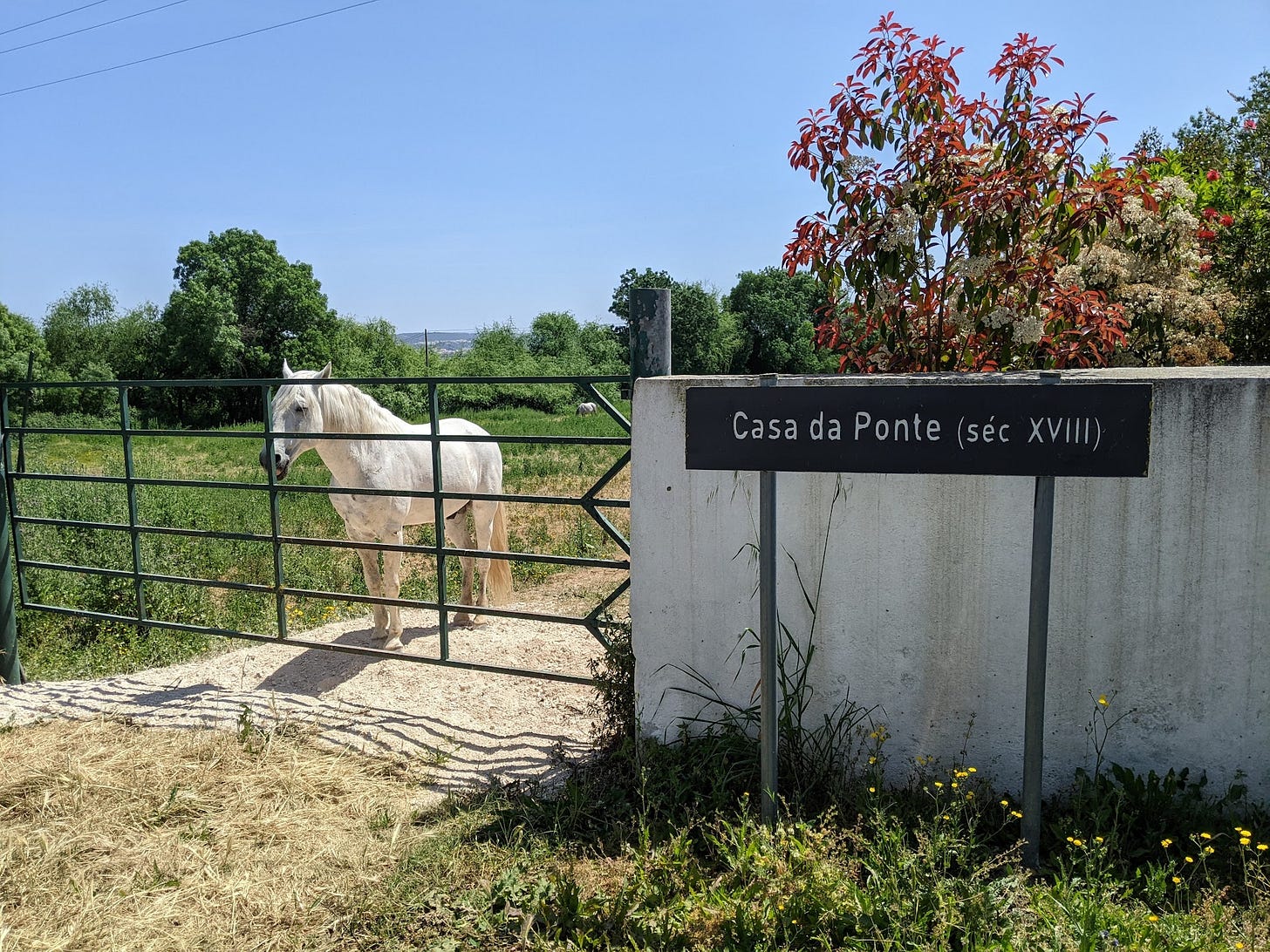
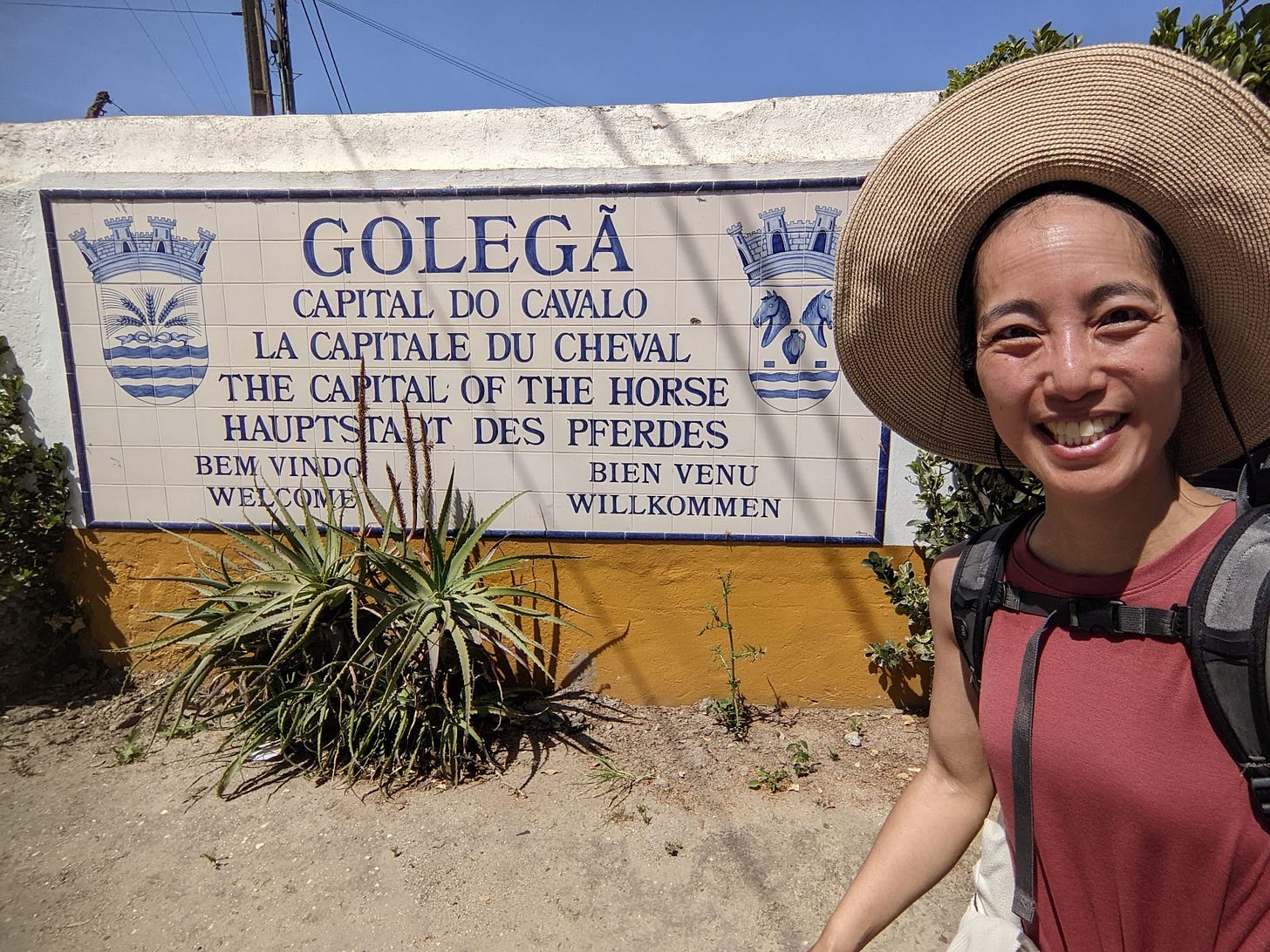
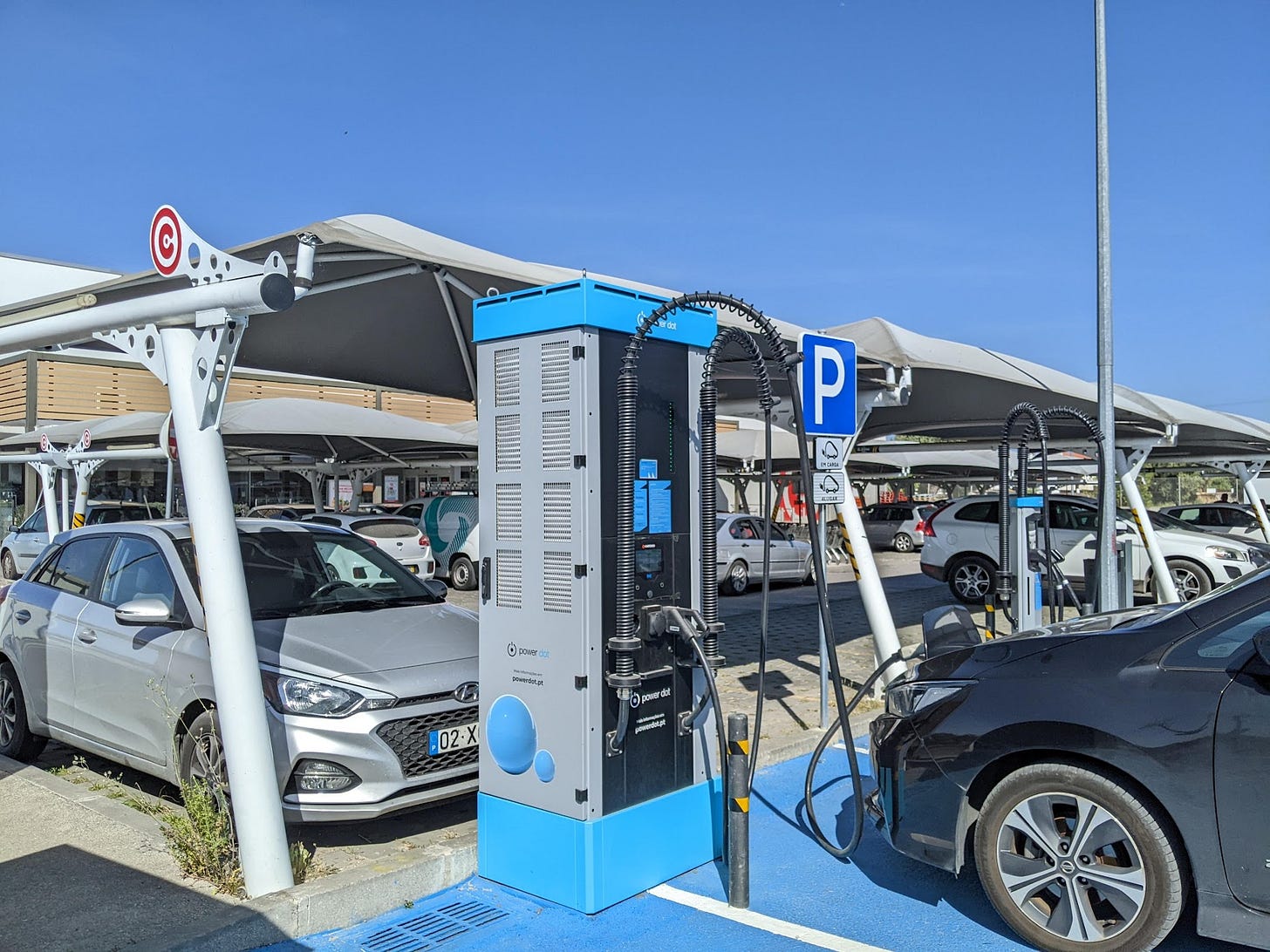
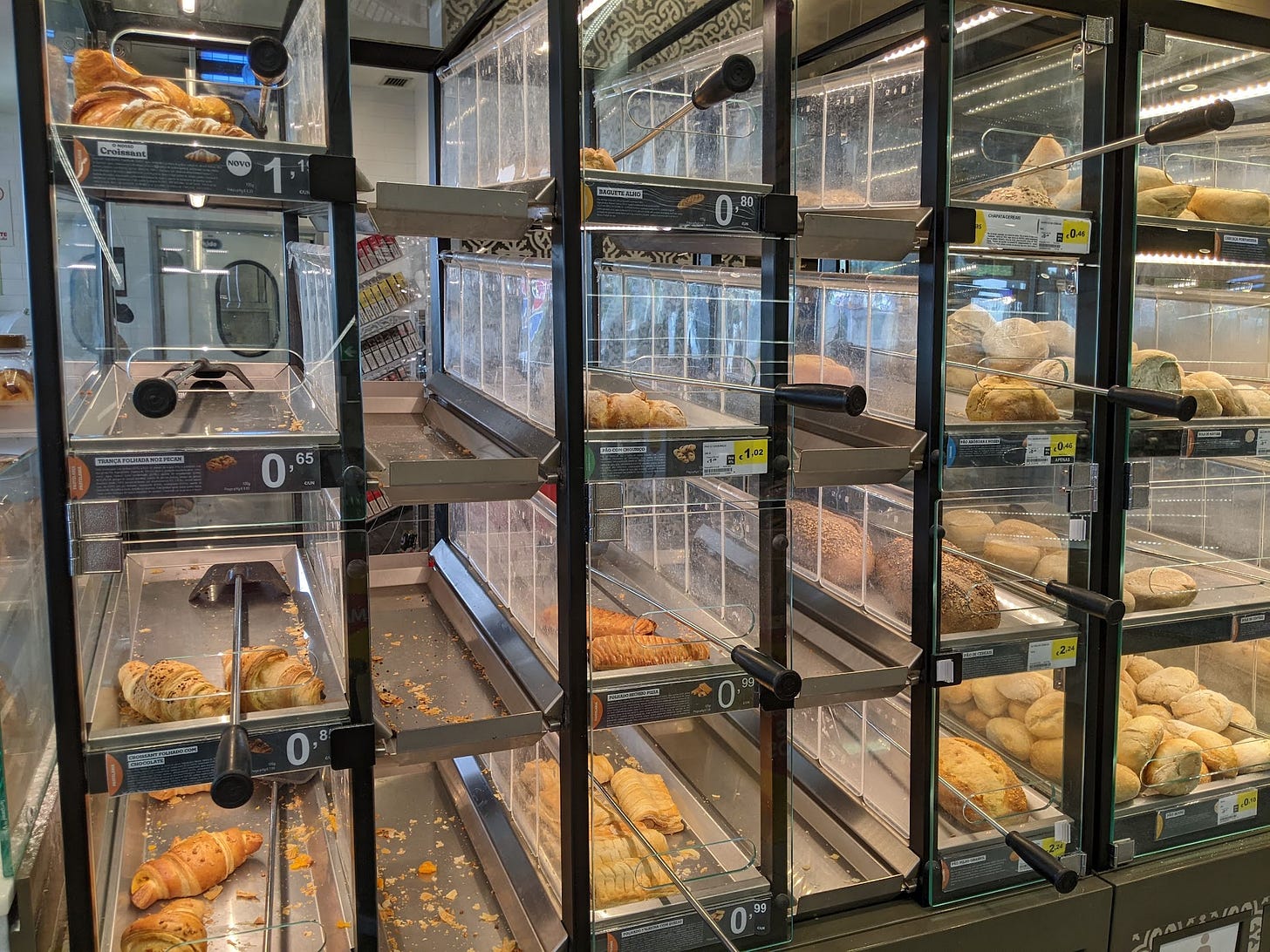
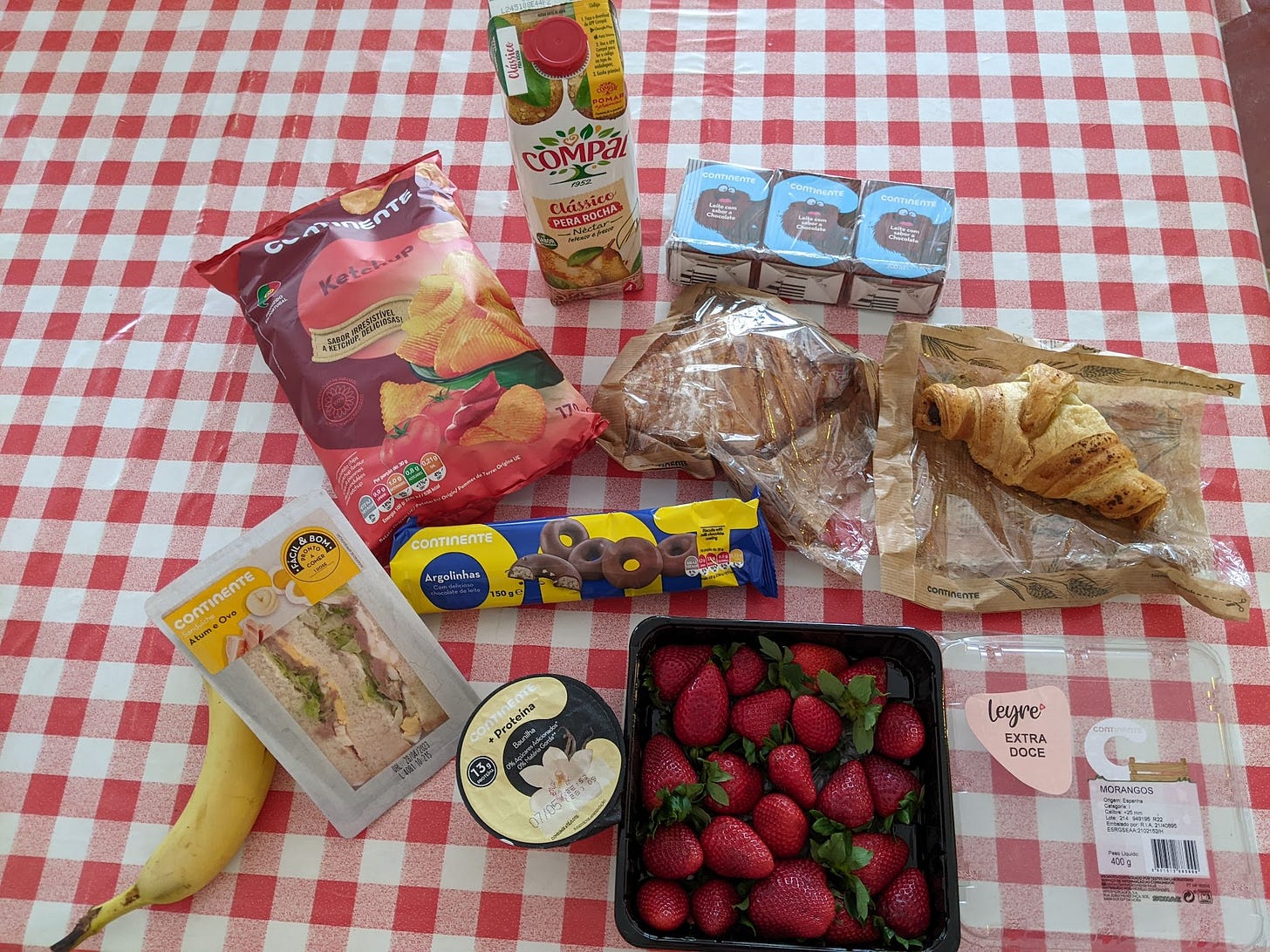

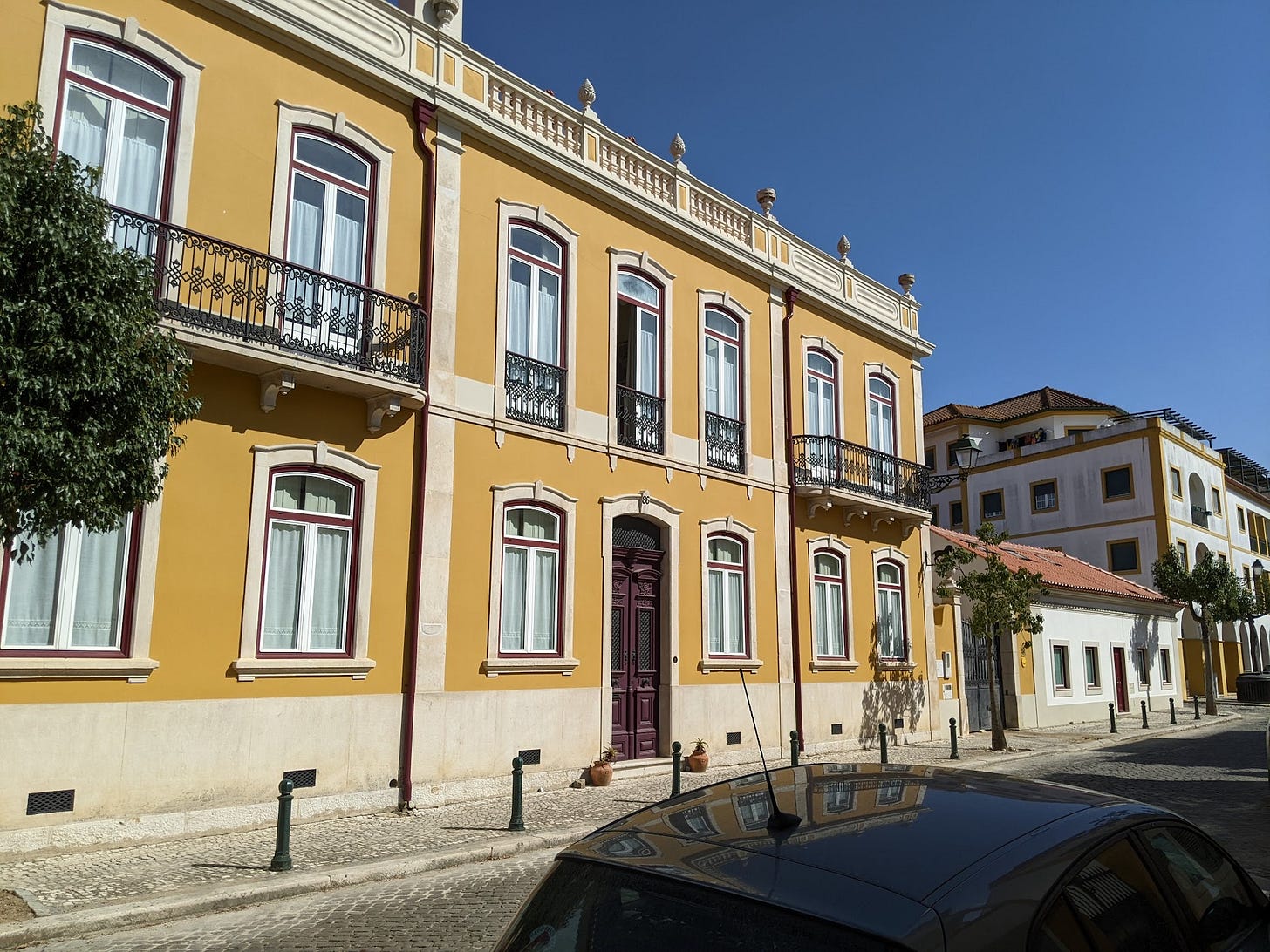
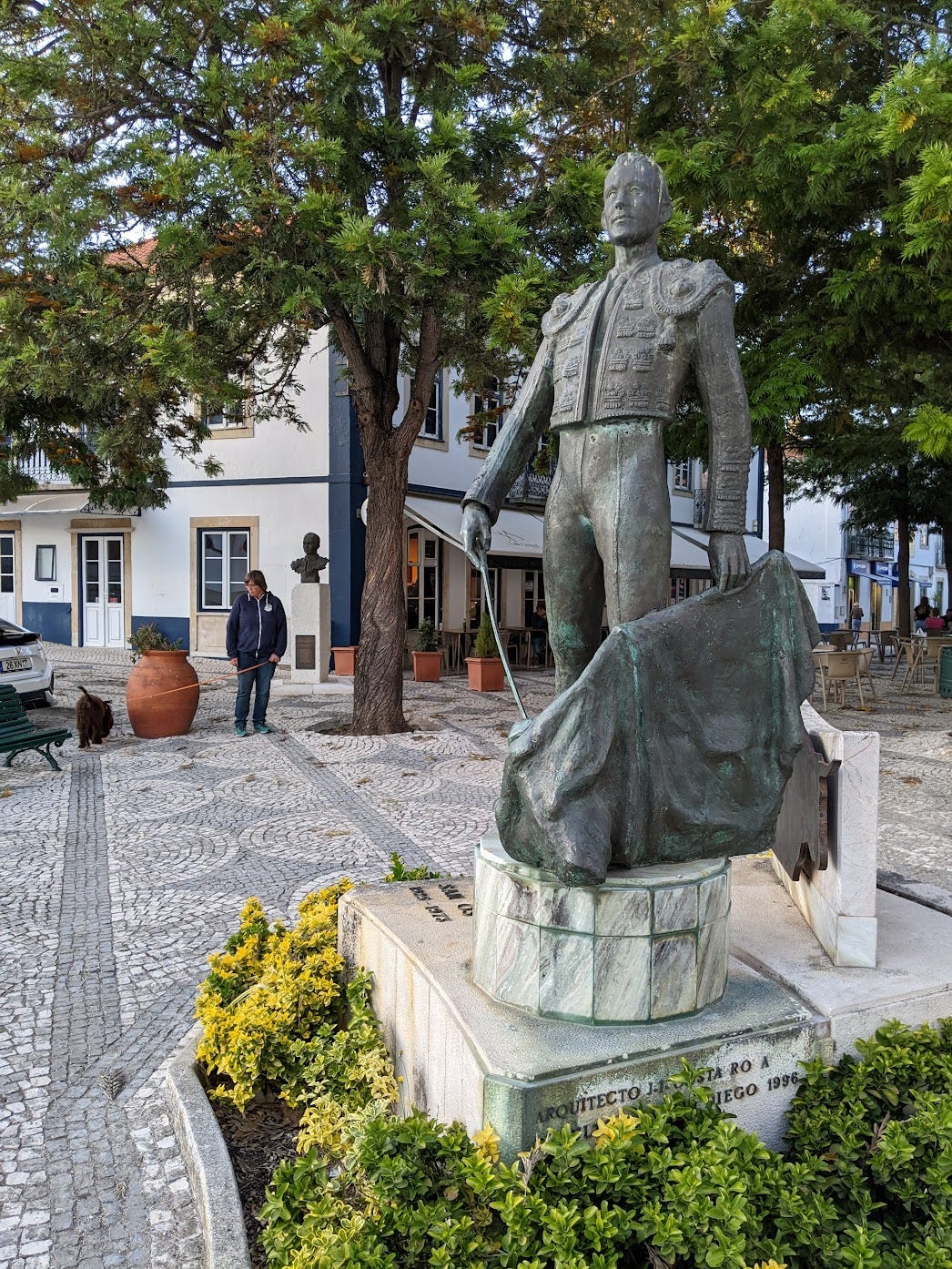
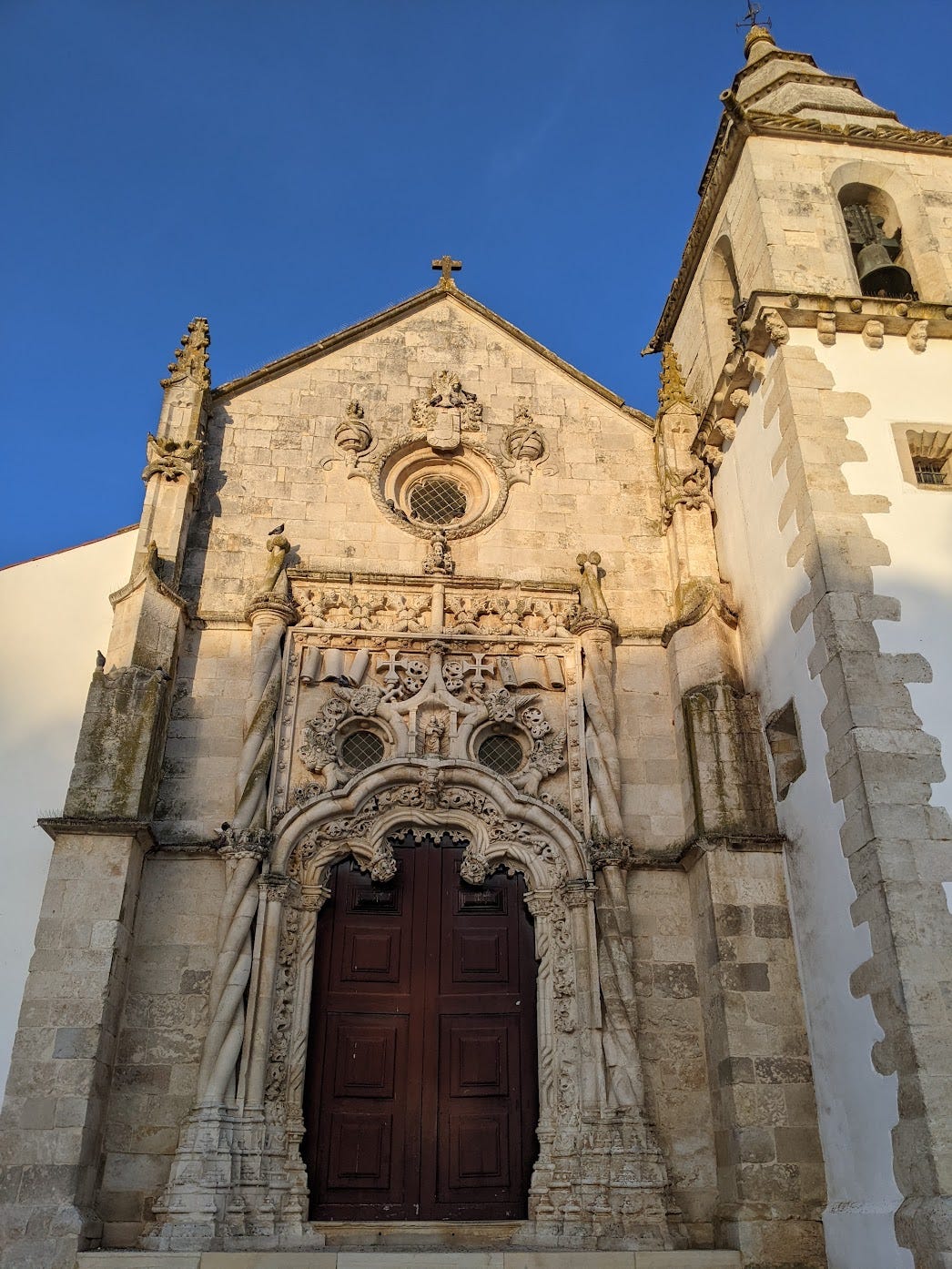
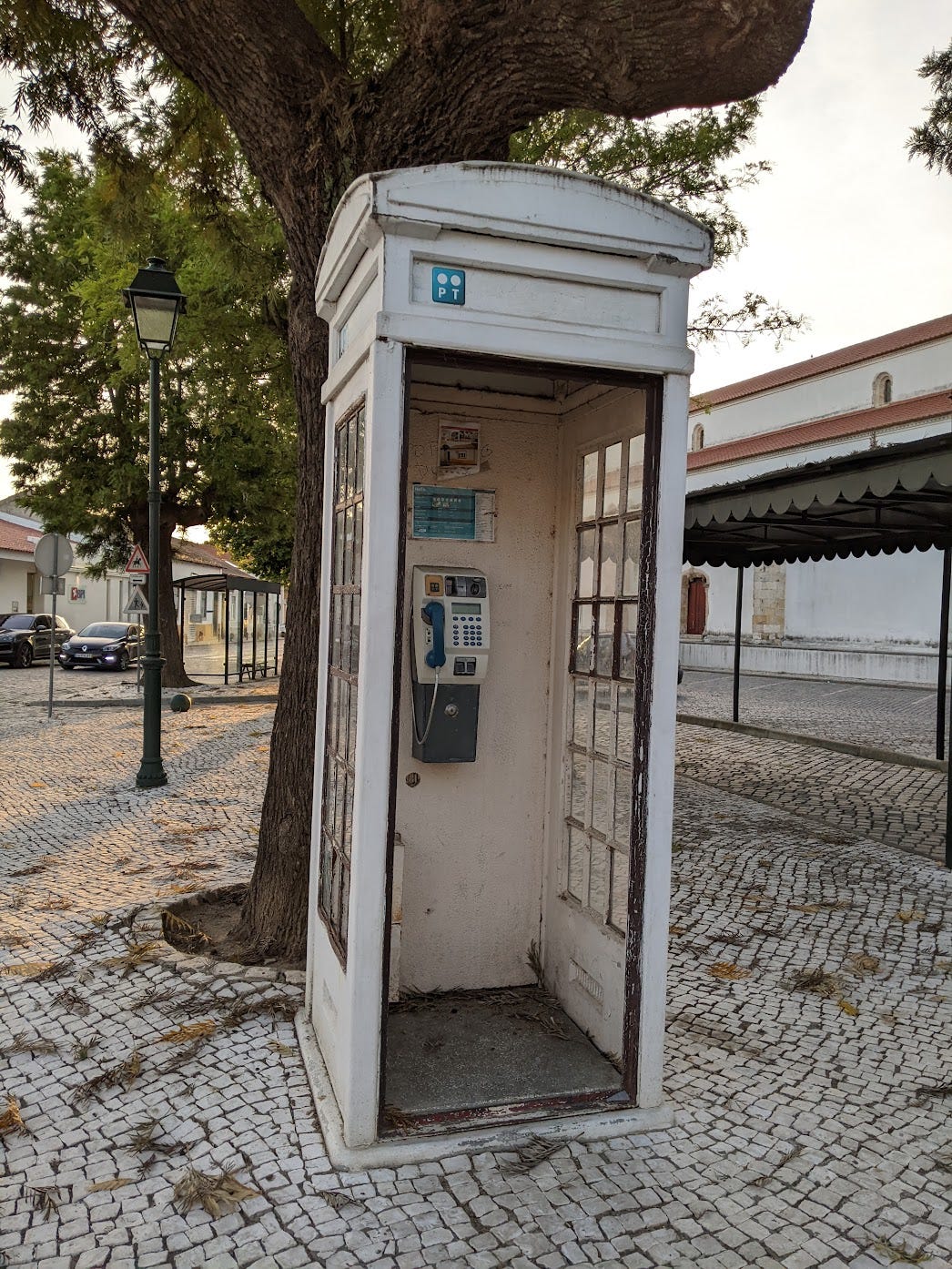
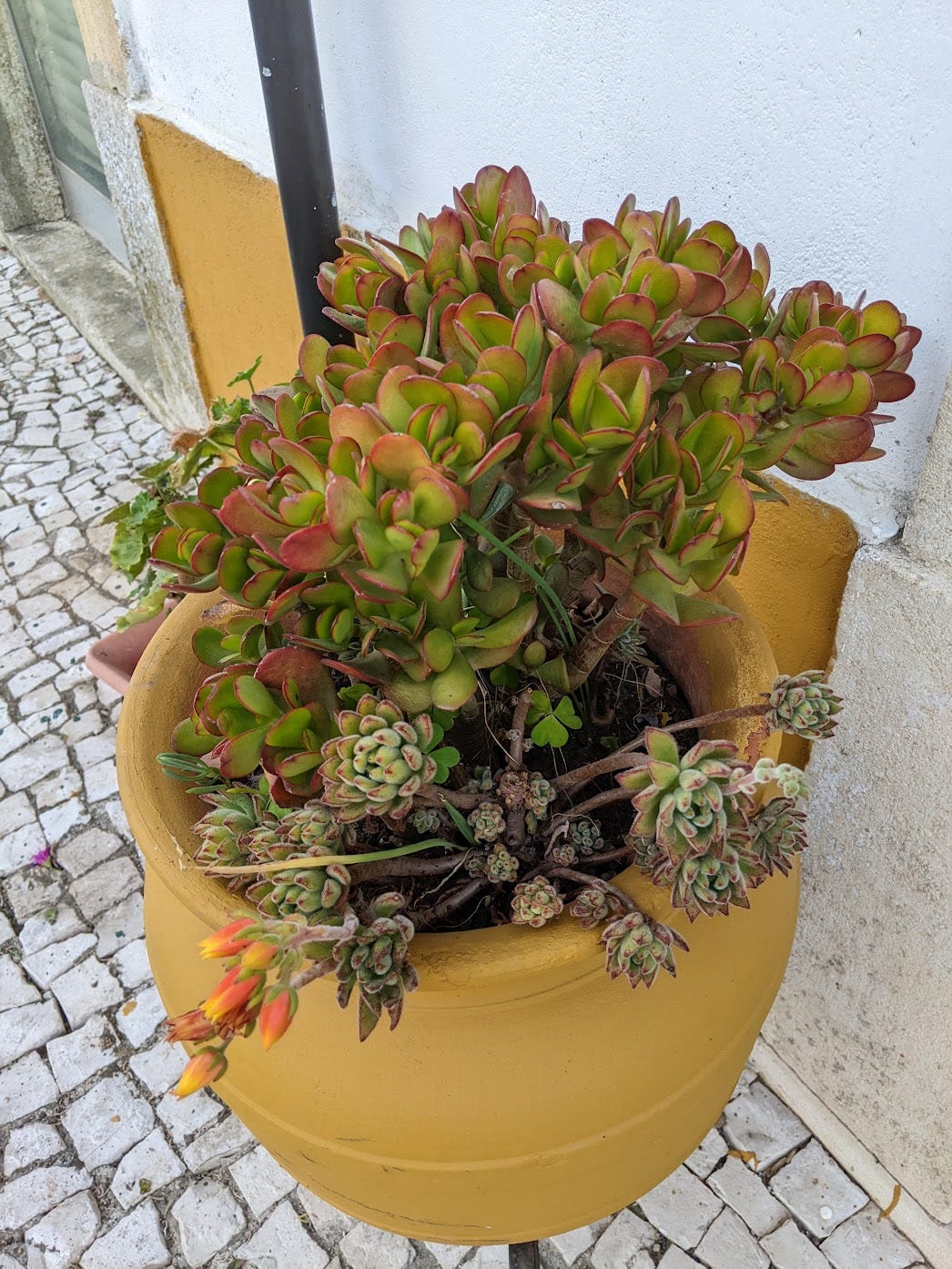
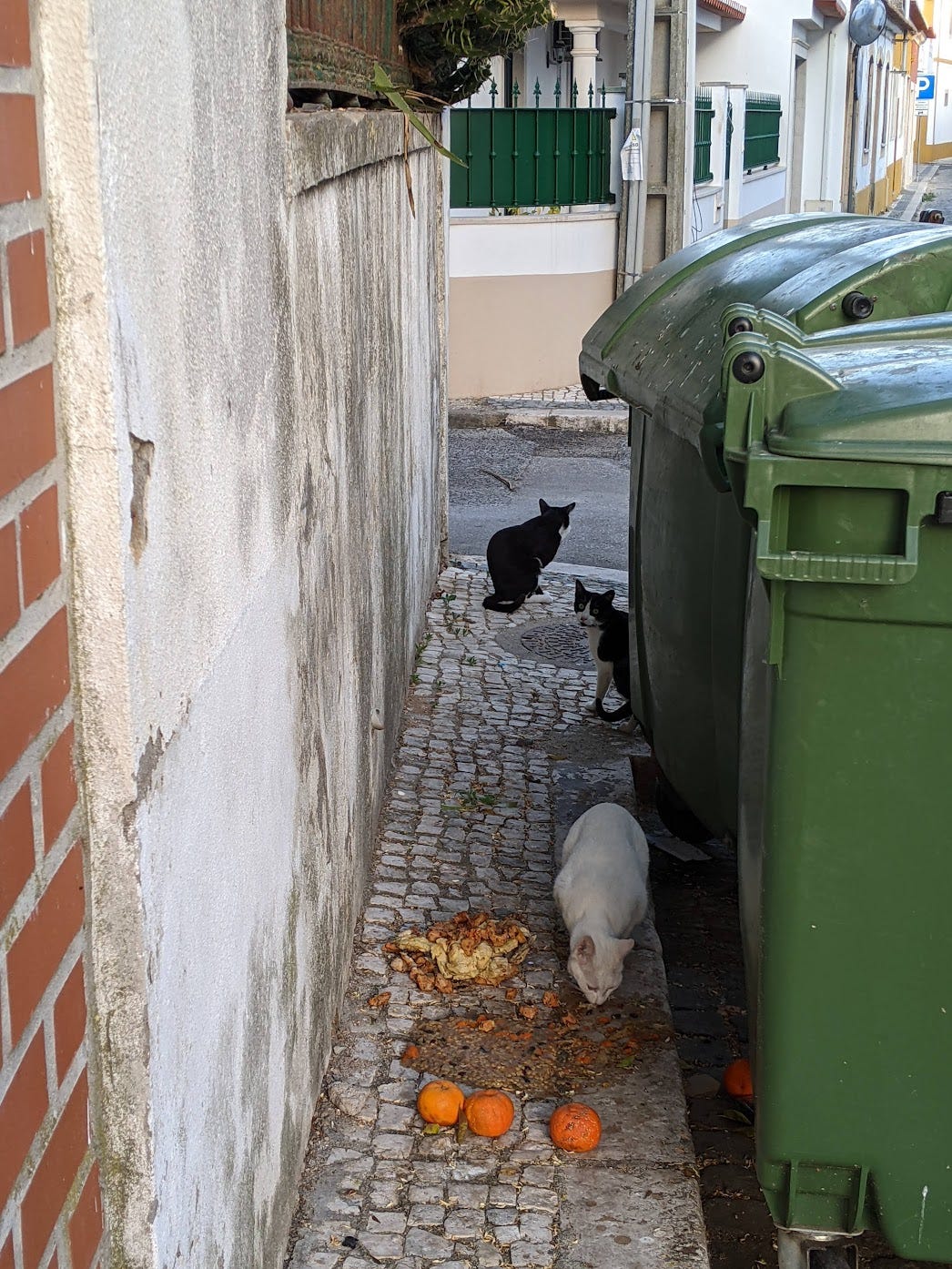


![[Camino Portuguese Day 0] Lisbon to Santarém](https://substackcdn.com/image/fetch/$s_!ZIYR!,w_140,h_140,c_fill,f_auto,q_auto:good,fl_progressive:steep,g_auto/https%3A%2F%2Fsubstack-post-media.s3.amazonaws.com%2Fpublic%2Fimages%2Fbd086769-ace0-4f4c-90ab-dcfebd052eb7_1892x1724.png)
![[Camino Portuguese Day 2] Golegā to Tomar](https://substackcdn.com/image/fetch/$s_!qflg!,w_140,h_140,c_fill,f_auto,q_auto:good,fl_progressive:steep,g_auto/https%3A%2F%2Fsubstack-post-media.s3.amazonaws.com%2Fpublic%2Fimages%2Fff663409-944e-46f0-bcf9-f9b1bc22e6e2_1046x1394.jpeg)